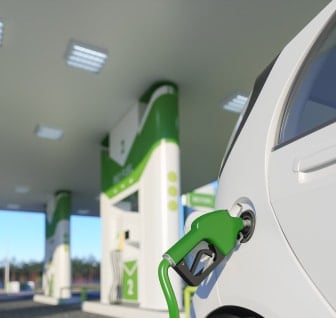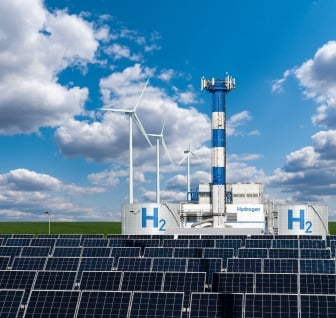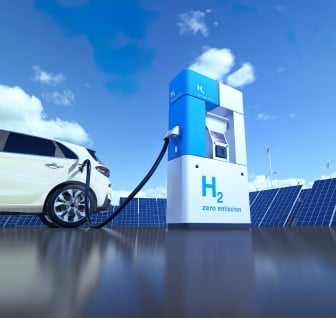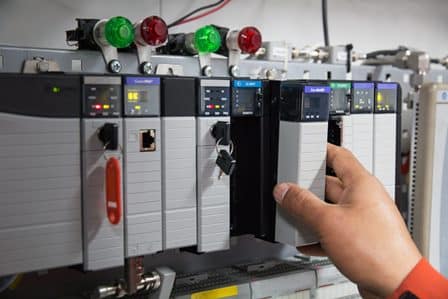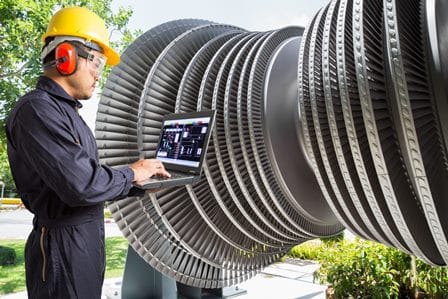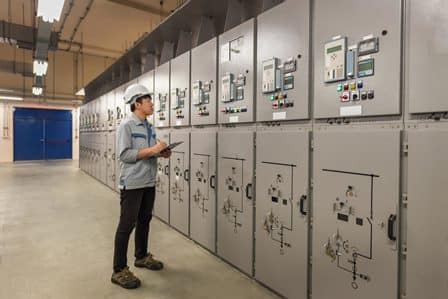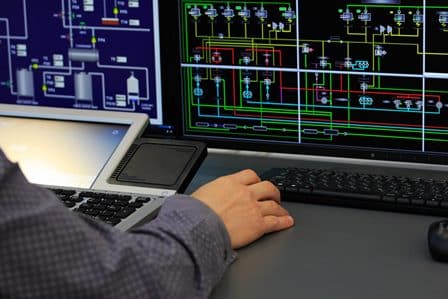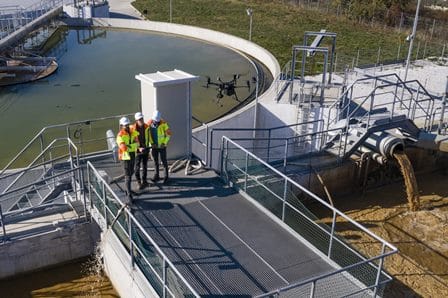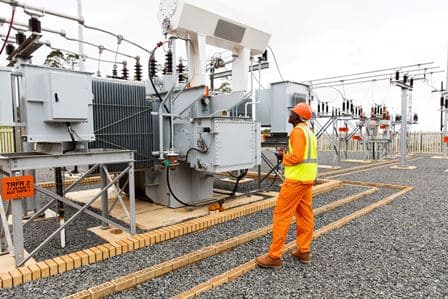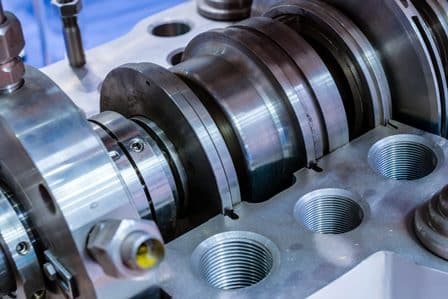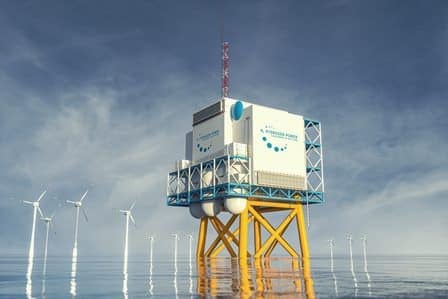52896WA Advanced Diploma of Civil and Structural Engineering (Materials Testing)
Investigation of the properties of construction materials, the principles which…Read moreGraduate Diploma of Engineering (Safety, Risk and Reliability)
The Graduate Diploma of Engineering (Civil: Structural) program covers 8…Read moreProfessional Certificate of Competency in Fundamentals of Electric Vehicles
Learn the fundamentals of building an electric vehicle, the components…Read moreProfessional Certificate of Competency in 5G Technology and Services
Learn 5G network applications and uses, network overview and new…Read moreProfessional Certificate of Competency in Clean Fuel Technology - Ultra Low Sulphur Fuels
Learn the fundamentals of Clean Fuel Technology - Ultra Low…Read moreProfessional Certificate of Competency in Battery Energy Storage and Applications
Through a scientific and practical approach, the Battery Energy Storage…Read more52910WA Graduate Certificate in Hydrogen Engineering and Management
Hydrogen has become a significant player in energy production and…Read moreProfessional Certificate of Competency in Hydrogen Powered Vehicles
This course is designed for engineers and professionals who are…Read more
Emergency Power Supplies: Electrical Distribution Design, Installation and Commissioning
THIS BOOK WAS DEVELOPED BY IDC TECHNOLOGIES
WHO ARE WE?
IDC Technologies is internationally acknowledged as the premier provider of practical, technical training for engineers and technicians.
We specialize in the fields of electrical systems, industrial data communications, telecommunications, automation and control, mechanical engineering, chemical and civil engineering, and are continually adding to our portfolio of over 60 different workshops. Our instructors are highly respected in their fields of expertise and in the last ten years have trained over 200,000 engineers, scientists and technicians.
With offices conveniently located worldwide, IDC Technologies has an enthusiastic team of professional engineers, technicians and support staff who are committed to providing the highest level of training and consultancy.
TECHNICAL WORKSHOPS
TRAINING THAT WORKS
We deliver engineering and technology training that will maximize your business goals. In today’s competitive environment, you require training that will help you and your organization to achieve its goals and produce a large return on investment. With our ‘training that works’ objective you and your organization will:
- Get job-related skills that you need to achieve your business goals
- Improve the operation and design of your equipment and plant
- Improve your troubleshooting abilities
- Sharpen your competitive edge
- Boost morale and retain valuable staff
- Save time and money
EXPERT INSTRUCTORS
We search the world for good quality instructors who have three outstanding attributes:
- Expert knowledge and experience – of the course topic
- Superb training abilities – to ensure the know-how is transferred effectively and quickly to you in a practical, hands-on way
- Listening skills – they listen carefully to the needs of the participants and want to ensure that you benefit from the experience.
Each and every instructor is evaluated by the delegates and we assess the presentation after every class to ensure that the instructor stays on track in presenting outstanding courses.
HANDS-ON APPROACH TO TRAINING
All IDC Technologies workshops include practical, hands-on sessions where the delegates are given the opportunity to apply in practice the theory they have learnt.
REFERENCE MATERIALS
A fully illustrated workshop book with hundreds of pages of tables, charts, figures and handy hints, plus considerable reference material is provided FREE of charge to each delegate.
ACCREDITATION AND CONTINUING EDUCATION
Satisfactory completion of all IDC workshops satisfies the requirements of the International Association for Continuing Education and Training for the award of 1.4 Continuing Education Units.
IDC workshops also satisfy criteria for Continuing Professional Development according to the requirements of the Institution of Electrical Engineers and Institution of Measurement and Control in the UK, Institution of Engineers in Australia, Institution of Engineers New Zealand, and others.
CERTIFICATE OF ATTENDANCE
Each delegate receives a Certificate of Attendance documenting their experience.
100% MONEY BACK GUARANTEE
IDC Technologies’ engineers have put considerable time and experience into ensuring that you gain maximum value from each workshop. If by lunchtime on the first day you decide that the workshop is not appropriate for your requirements, please let us know so that we can arrange a 100% refund of your fee.
ONSITE WORKSHOPS
All IDC Technologies Training Workshops are available on an on-site basis, presented at the venue of your choice, saving delegates travel time and expenses, thus providing your company with even greater savings.
OFFICE LOCATIONS
AUSTRALIA • CANADA • INDIA • IRELAND • MALAYSIA • NEW ZEALAND • POLAND • SINGAPORE • SOUTH AFRICA • UNITED KINGDOM • UNITED STATES
idc@idc-online.com www.idc-online.com
Visit our website for FREE Pocket Guides
IDC Technologies produce a set of 6 Pocket Guides used by thousands of engineers and technicians worldwide.
Vol. 1 – ELECTRONICS
Vol. 2 – ELECTRICAL
Vol. 3 – COMMUNICATIONS
Vol. 4 – INSTRUMENTATION
Vol. 5 – FORMULAE & CONVERSIONS
Vol. 6 – INDUSTRIAL AUTOMATION
To download a FREE copy of these internationally best selling pocket guides go to: www.idc-online.com/downloads/

Presents
Emergency Power Supplies: Electrical Distribution Design, Installation and Commissioning
Website: www.idc-online.com
E-mail: idc@idc-online.com
IDC Technologies Pty Ltd
PO Box 1093, West Perth, Western Australia 6872
Offices in Australia, New Zealand, Singapore, United Kingdom, Ireland, Malaysia, Poland, United States of America, Canada, South Africa and India
Copyright © IDC Technologies 2008. All rights reserved.
First published 2008
All rights to this publication, associated software and workshop are reserved. No part of this publication may be reproduced, stored in a retrieval system or transmitted in any form or by any means electronic, mechanical, photocopying, recording or otherwise without the prior written permission of the publisher. All enquiries should be made to the publisher at the address above.
ISBN: 978-1-921007-84-2
Disclaimer
Whilst all reasonable care has been taken to ensure that the descriptions, opinions, programs, listings, software and diagrams are accurate and workable, IDC Technologies do not accept any legal responsibility or liability to any person, organization or other entity for any direct loss, consequential loss or damage, however caused, that may be suffered as a result of the use of this publication or the associated workshop and software.
In case of any uncertainty, we recommend that you contact IDC Technologies for clarification or assistance.
Trademarks
All logos and trademarks belong to, and are copyrighted to, their companies respectively.
Acknowledgements
IDC Technologies expresses its sincere thanks to all those engineers and technicians on our training workshops who freely made available their expertise in preparing this manual.
Contents
1 Emergency Power Needs 1
1.1 Problems of power failure in industries 1
1.2 Tolerance for interruptions and Voltage/ frequency excursions 5
1.3 Uninterrupted power, emergency power and standby power 8
2 Emergency Power – Options 11
2.1 Different solutions for different needs 11
2.2 UPS for critical loads and various available options 23
2.3 Battery as source: types and their pros and cons 45
3 Configuring Power Distribution Systems for Emergency Loads 57
3.1 Integrating emergency and critical power needs in distribution networks 57
3.2 Multiple units nearer consumer vs larger centralized units 62
3.3 Typical distribution scenarios in large industrial systems for integration of emergency power 64
3.4 Capacity and voltage planning for emergency power in large industries 65
4 Special Requirements for Emergency Systems 69
4.1 Control room power and escape route lighting 69
4.2 Automation of starting, load changeover and shutdown 69
4.3 UPS and other power conditioning requirements 71
4.4 Paying attention to motor starting requirements and accompanying voltage sag 72
4.5 Safe shutdown requirements 75
5 Harmonics in Emergency Supply Systems 77
5.1 Harmonic producing load and their best effect on generator capacity 77
5.2 Tackling harmonics produced by static UPS 79
6 Parallel Operation of Emergency Generators 83
6.1 Parallel operation between emergency sources 83
6.2 Load sharing between sources 86
6.3 Parallel operation of emergency sources with utility (normal) source 88
6.4 Pros and cons of operation 89
6.5 Automation for paralleling- available equipment 89
6.6 Utility stipulations and local codes 90
7 Tie Protection Systems 93
7.1 Avoiding emergency generator collapse on external events 93
7.2 Appropriate protection: reverse power, frequency rate and vector surge relays 94
7.3 Islanding of systems and generator behavior 96
7.4 Load management in islanded systems 96
8 Emergency power equipment installation 99
8.1 Ensuring availability of critical power supplies through proper installation 99
8.2 Equipment cooling, premises ventilation and noise control measures 101
8.3 Fuel storage requirements 104
8.4 Special requirements in extreme climates 111
8.5 Regular routine start up for checking 112
8.6 Diesel Generator Troubleshooting 113
9 Emergency power equipment – Cabling and Earthing 117
9.1 Earthing of emergency power sources 117
9.2 Special requirements for multiple generator earthing 120
9.3 Grounding of UPS derived supplies 121
9.4 Cable sizing issues 127
9.5 Routing of cables: precautions to avoid simultaneous failures by physical separation 133
9.6 Emergency power for hazardous installations 133
10 Safety in Emergency Power Supplies 135
10.1 Fire safety 135
10.2 Battery safety 138
A Appendix A 139
Practical Exercises
1
Emergency Power Needs
1.1 Problems of power failure in industries
The primary intention of any power utility is to provide uninterrupted power supply to its consumers. Unfortunately, interruptions can and do happen occasionally. There are several causes for interruption such as:
- Equipment failures and line faults
- System instability leading to tripping
- Deliberate tripping (usually automatically) to save a system from collapse
- Human errors
- Natural causes such as hurricane, earthquakes and floods
No power system, regardless of how well it is designed or maintained, can be guaranteed to be free from interruptions. While a high degree of continuity can be ensured, it is quite impossible to guarantee that there will be no interruption of power in the whole of a system.
System instability usually follows a major disturbance such as loss of a generating unit, tie-line tripping etc. Installation and use of adequate reserves in the system may mitigate such events. Deliberate tripping by islanding schemes is also sometimes done to save at least part of a system during major system failures thus enabling faster restoration. Failures due to natural calamities are not preventable, but with adequate warning, steps can be taken to mitigate the effects by advance preparations.
Equipment failures and line faults can be reduced to an appreciable extent by proper selection of equipment and their maintenance. In the event of tripping on faults, power supply can be restored using several options, some of these being:
- Auto-reclose operations (for self clearing of transient faults)
- Switching to redundant feeders
- Starting standby generating sources
System outages are more likely in a system without adequate generation reserve. Electrical energy is something that is consumed as it is being generated. No buffer storage is possible in a transmission or distribution network. When there is a sudden load increase, which is beyond the capacity of the system to meet, the frequency of the system falls. Increasing the generation from available spinning reserve can halt the frequency drop, but where this is not possible (due to inadequate reserve availability) a complete system collapse is likely. When the load change is anticipated and is gradual, it is possible to start standby capacity and synchronize them with the system so that excess load can be taken up. Engine generators and gas turbines are capable of quick start and can start supplying load almost immediately, thus taking up peak demands in the system.
It is necessary to understand the effect, a sudden power interruption can have on an industrial facility. An interruption can have costs associated with it, some of which are direct and others indirect. This provides a justification for planning special equipment such as UPS systems to ensure that there are no unscheduled interruptions of supply. The higher the costs associated with an interruption, the more reliable the supply should be and the higher the investment that is justifiable to ensure reliability.
A power failure can result in one or more of the following:
- Accidents involving death or injury
- Damage to equipment
- Creation of potentially hazardous conditions
- Loss of production (not only for the duration of the interruption but also during the time required to bring the process to its pre-failure state)
What kinds of accidents can result from a sudden interruption? The following are some of the possible scenarios.
- Dropping of loads lifted by electromagnets
- Release of toxic materials
- Spillage of chemicals or hot metal
- Explosions
- Runaway reactions
All these can result in accidents. In some cases, though there may be no injury to human beings, such sudden failures of power supply can cause extensive damage to equipment. Following are some examples of such situations:
- Lubrication failures
- Solidification of molten material
- Failure of cooling water flow
In many cases, the equipment affected by the power failure itself may be very minor such as a lubrication pump. But when the power supply to this equipment fails, it puts a much a larger and critical equipment (such as a large compressor) at risk of damage. The resulting disruption to a process as a result of the failure can be substantial and so would be the cost of putting the system back on stream.
In some cases, failure of power supply can cause potentially hazardous situations. Some examples for such situations are:
- Loss of control power
- Loss of lighting in operational areas or exit routes
- Loss of ventilation/exhaust systems
- Loss of signaling and alarms
- Loss of fire-fighting systems
In many cases, the equipment involved is relatively minor. But under specific conditions such as a total supply failure, they may create hazardous situations. For example, lighting failure during a power outage may result in accidents because exit routes are not illuminated or control room operations may get affected due to delayed restoration or safe shutdown activities.
A common result of an interruption is the stoppage of a process which results in lost production. If the production loss is confined to the period of power interruption, it may not be serious. Often the process takes much longer time to attain its original pre-failure status with consequent higher loss of production. Refer to Figure 1.1.

Production behavior as a result of power interruption
In Figure 1.1, axis E denotes the production efficiency, ta the time of interruption and ts the restarting time. It may be noted that:
- Restarting itself is not instantaneous and takes a finite amount of time
- Efficiency does not catch up at the end of restarting time, with the value existing prior to interruption
If the interruption also results in equipment damage, the time required to repair the damage and restart the production can be much higher and so will be the production loss.
Now consider the aspect of cost of interruption. As stated earlier there can be direct costs as well as indirect costs. Some of the examples of direct costs are:
- Costs due to lost man-hours
- Direct expenses due to death/injury
- Cost of repairs to damaged equipment
- Lost production
In some cases, the costs may be indirect as well. The following examples will illustrate this:
- Legal costs in the case of accidents involving third parties/quality problems/non-fulfillment of contract commitments
- Loss of good will
Hence a power interruption can cost an industry considerably in financial terms. Planning of an electrical system to achieve the desired degree of continuity of power and the investment required must therefore relate to the direct and indirect costs of power interruption in a facility.
One of the solutions that is increasingly being adopted is the installation of distributed generation capacity in a system. Utilities either own such capacity themselves or permit industrial consumers/other third parties to set up this capacity and operate them in tandem with the system. This has several advantages.
- They are usually close to the load and are not affected by transmission circuit problems
- They are usually capable of being started and brought up to load faster
- When owned by industrial consumers they also serve as standby sources
- When run as base-load generators synchronized with the utility system they can serve as uninterrupted power source for the consumer
- They improve the voltage profile in remote end-of-line distribution circuits
Often, cleaner energy technologies are used in these equipment (such as biomass power plants and fuel cell generation units)
A typical standby generation scheme of an industrial plant is shown in Figure 1.2. The scheme is based on an engine driven generator and has the capacity to feed critical loads only. Normally all the plant loads including the critical loads are supplied by the electric utility. When the utility supply fails, the critical loads are transferred to generator supply using the open transition changeover switch. Since the switch is break before make type, a transfer from one supply to another is accompanied by a power interruption. Where such interruption is unacceptable, other types of schemes will be needed.

Industrial plant – Standby generation
1.2 Tolerance for interruptions and voltage/frequency excursions
Any electrical equipment is designed with certain tolerances for their input supply voltage. Also, the design may have in-built features which take care of voltage variations to some extent. Many modern office equipment including desktop computer systems can tolerate voltage fluctuations to some extent by virtue of large capacitances (in relation to load currents) and internal regulation circuitry and can ride through voltage sag or even a momentary interruption.
The tolerance range for voltage fluctuations for general industrial equipment is normally in the range of –10 to +6% for slow/sustained variations (sag/swells) and considerably more for short time disturbances.
1.2.1 CBEMA, ITIC and ANSI Voltage Sensitivity Curves
The topic of voltage sensitivity has received a lot of attention in relation to computers, as the early computer designs were very susceptible to voltage variations and a number of random data errors used to happen because of this. The studies resulted in the development of standard curves indicating the voltage limits plotted against the time for which the limits can be reached without causing ill effects. The earliest of these curves were developed by the Computer and Business Equipment Manufacturers Association (CBEMA) and is shown in Figure 1.3.

CBEMA voltage sensitivity curves
The curve defines the limit of voltage variation from 100 microseconds for positive variations and 20 milliseconds for negative variations. It can be seen that 100% sag (supply interruption) can be safely tolerated for duration up to 20 milliseconds. A voltage of 375% of rated value can be tolerated for duration of 100 microseconds.
Note that such a short duration of voltage rise is what happens during a surge induced by lightning with the safe withstand value defined by the Basic impulse Level (BIL).
In can be said that the upper and lower curves taken together represent the envelope within which the equipment should continue to function without interruption or data loss. As far as dips are concerned, it is the lower limit line that is of interest. This line represents the boundary between survivable and non-survivable dips.
It should be noted that these curves are based on voltage sensitivity exhibited by computer equipment and may not be directly applicable to power equipment. The CBEMA curves have been further refined by Information Technology Industry Council (ITIC) and by ANSI (as IEEE 446) and the curves suggested by these bodies are shown in Figures 1.4 and 1.5 respectively.
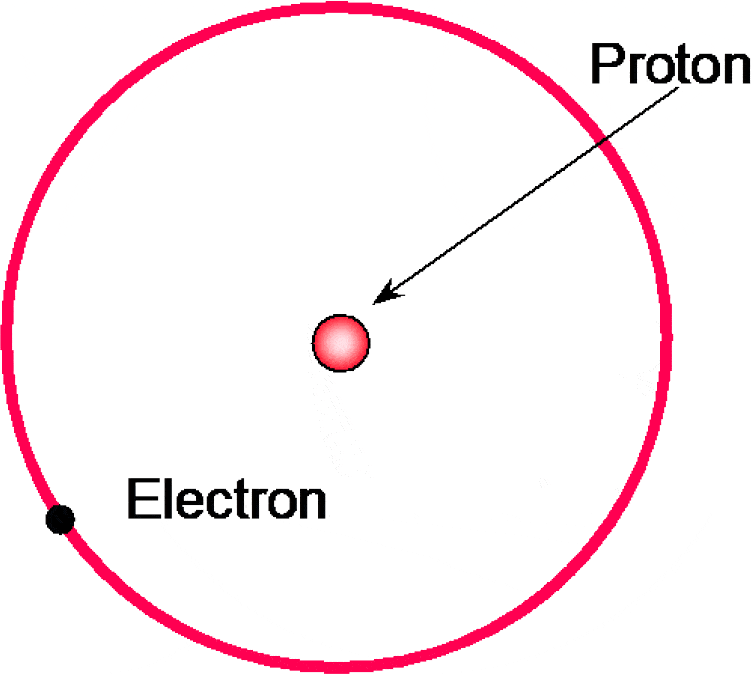
ITIC voltage sensitivity curves

ANSI voltage sensitivity curves
In contrast to CBEMA curves, the ITIC and ANSI curves define the limits starting from 1 millisecond. A single curve may not fit all equipments and the designer may choose to apply a particular set of curves, which would best suit the equipment in question. In many cases, it is however the power system which may prove to be the problem. The variations that occur in a system where a particular item of equipment has to be located may not fall within the envelope defined by the sensitivity curves applicable for that equipment. Figure 1.6 below illustrates this point by superimposing the negative side envelope of the ITIC curve with the voltage dips that commonly occur in a system. It may be seen that a substantial part of the curve, representing system voltage dips, falls outside the ITIC lower limit envelope. In this case the equipment tolerance that is to be adopted by the design should correspond to the curve marked as ‘Required tolerance’.

Practical system limits superimposed over ITIC lower envelope
It may or may not be possible to design equipment to match the ‘required tolerance’ curve. The alternative is to use various correction measures, which either deal with the effect of voltage variations or correct the voltage variations so that the input voltage to the equipment meets the requirements.
1.3 Uninterrupted power, emergency power and standby power
Certain critical processes and operations like computer installations, life support systems will not tolerate even momentary power interruptions. These kinds of processes require a reliable and continuous power supply in the event of failure of utility power supply. Such processes need to be supplied power by means of uninterrupted power supply source. As the name suggests, an uninterrupted power supply system guarantees continuous power without even a momentary break to the connected loads.
Emergency power is the minimum backup power required for emergency applications like emergency lighting, emergency shut down systems in petrochemical processes, alarm systems, elevators, life safety and security systems. The term ‘emergency equipment’ is used for those loads where a brief interruption can be tolerated but to which power should be restored as quickly as possible.
Standby power refers to the provision of substantial power to maintain all the production and business processes during power outages either for short period of time or an extended period of time. Examples of facilities that need standby power are semiconductor manufacturing plants, airports, hospitals, apartments, telecommunication establishments and office complexes.
2
Emergency Power – Options
2.1 Different solutions for different needs
When we talk about power quality or continuity, the needs of the equipment to which the power is supplied require careful consideration. For example, the following questions should be asked to assess what the equipment actually needs in terms of quality and continuity of power:
- Can the load tolerate a power interruption? If yes, for how long?
- What is the effect of a power failure?
- Are there associated costs?
- Are there safety hazards associated with a failure?
When trying to answer these questions, it will be found that absolute continuity of power supply is not a requirement for many loads. Many types of equipment can tolerate varying periods of power interruption ranging from a few milliseconds to a few minutes. A system designer must therefore firstly analyze the equipment needs and group the loads according to their requirements of power reliability. While theoretically it may be possible to ensure a very high reliability of power in the whole of a distribution network, the investments required to achieve this will often be very high and therefore uneconomical. Thus, grouping according to actual requirements and providing appropriate measures for improved reliability based on the needs of the group will result in an economical design. Safety hazards must however take priority.
2.1.1 Gas turbine based sources
The principle used in a gas turbine is similar to that used in the jet engines of air planes. The main components of the gas turbine generator are:
- Air Compressor
- Combustion chamber
- Turbine
- Electrical generator
- Starting motor
Figure 2.1 illustrates the schematic of a gas turbine driven generator:

Schematic of Gas turbine generator
As can be seen in Figure 2.1, the compressor, turbine and the generator are all mechanically coupled together. The turbine drives the compressor and the generator. The compressor takes in air and compresses it before delivering it to the combustion chamber. In the combustion chamber, fuel is injected by means of multiple nozzles and burnt, producing hot, high pressure gas in the process. Various grades of the following fuels are used for firing the gas turbine:
- Oil in gasified form
- Gasoline
- Natural gas
- Propane gas
- Coal in gasified form
This high pressure gas is then passed through the vanes of the turbine where the energy of the gases is converted into kinetic energy. The efficiency and power of the gas turbine is dependant on the temperature of the gas. The higher the temperature of the gas, the higher the power and efficiency of the turbine. The turbine, in turn, drives the compressor and the generator. The starting motor is used for the purpose of starting the gas turbine.
Figure 2.2 shows the scheme of a combined cycle gas turbine power plant. Here the spent gas coming out of the gas turbine is directed to a heat recovery steam generator where the heat from the exhaust gas is recovered and utilized for generation of steam. The steam so generated is further used for driving a steam turbine. Consequently, a combined cycle gas turbine system is more efficient than a simple gas turbine.

Combined cycle gas turbine power generation
Gas turbine based generators have several advantages over other types of emergency generators.
- Low installation cost
- Modular construction
- Simple mechanical transmission
- Short manufacturing cycle, delivery time
- Adaptability for complete automation
- Quick start
- Quick load pickup
- Low emission levels (environmental friendly)
Gas turbine is an apt solution when taking into consideration the above advantages, the availability of fuel and the usability of heat recovered from the exhaust gases of the turbine (this heat may be used to preheat water intended for a steam boiler).
Micro Turbine Generator
Micro turbine generators are now becoming popular owing to their compact size and ease of operation. The main features of micro turbine generator are as follows:
- Small, high speed, integrated power plant –includes compressor, turbine, generator, power electronics
- Power output range – 30kw ~ 300 kw
- Deployed in cogeneration schemes – Generate electricity, heat air or water with exhaust gas
- Use natural gas, propane and other fuels
- Flexible – Number of units of any rating can be paralleled to handle loads
- Generate power where it is used
- Fast, Easy Installation and Operation
- Power Security and certainty
- Per-kWh emissions lower than utility plants
- Boost Capacity without utility costs, delays
- Gives end-users energy cost control
- Maximizes Energy Efficiency via CHP

Combined cycle gas turbine power generation
2.1.2 DG based sources
Diesel generators are the most often used source for standby and emergency power in industries. The diesel engine is the prime mover for the generator and offers reliable, long term service as well as being adaptable to the auto start and synchronizing system. The diesel generators can be operated in the following various modes:
- Single generator system – Suitable for small power requirements
- Multi generator system – Where power requirement is higher and redundancy is required
- Standalone systems
- Operation in synchronization with the utility grid: increased reliability
Starting and synchronization of the genset takes a definite amount of time, during which time, power is interrupted for the load in a standalone system. Where interruption cannot be tolerated, the generators are operated continuously in synchronization with the grid, and in the event of failure of the grid supply, the site generator continues to supply the critical loads even after isolation from the grid. Disadvantages with diesel generator power supply include noise, pollution due to exhaust, rigorous maintenance requirements, the need for additional space and equipment for fuel storage, as well as the need for ventilation and cooling systems. Figure 2.4 shows the schematic of the subsystems of the engine: the fuel system, lubrication system, air intake and exhaust system and cooling system.

Typical subsystems of the engine of a Diesel generator
The engine is recommended to have a minimum of 110% of the generator rated capacity at the specified fuel and rated ambient temperature. The performance of the engine should be guaranteed for 1/4, 1/2 and full load operation at ambient temperature and atmospheric pressure.
The starting system of the engine should be capable of automated starting and enable supply to the load within 10 seconds of initiating the starting signal. For engines provided with DC starter motor, the battery should have the capacity for the specified number of multiple starts without battery charging. It is recommended to have an alternate back-up starting system of either battery-DC starter motor design, compressed air starting and a provision for manual starting for improved reliability. The batteries should be of heavy duty, long life design having 20 years minimum design life.
The cooling water system should have the following provisions:
- Cooling water low flow and high temperature switches for alarm
- Cooling water temperature sensor in the outer manifold
- Thermal relief device protection against blockage problem
The generator should be preferably provided with a brushless exciter and electronic automatic voltage regulator (AVR). The voltage regulator should provide automatic protection for the generator system from three phase short circuits. The voltage regulator should have under frequency protection to allow the generator to be operated at no load, and at less than synchronous speeds for engine start up and shut down sequences. The exciter should have a fast response, low time constant to minimize voltage transients under severe load changes. Figure 2.5 shows the schematic of an engine generator with brushless exciter:

Brushless generator – Circuit schematic
The various main features recommended in an engine driven generator are as follows:
Air intake and exhaust system:
- Air filter should be replaceable element, heavy duty, dry type having minimum intake pressure drop and differential pressure indication
- The design of the intake and exhaust should be such that noise is reduced to a minimum
Lube oil system:
- Oil filter or strainer should be installed at the suction side of the lube oil pump. The pump should be the positive displacement type with adjustable pressure regulation
- Hand priming pump should be provided
- An oil cooler should be provided
- Low pressure shut down protection for lube oil should be provided
- Lube oil low pressure and high temperature alarm should be provided
Operating functions:
- Unattended remote automatic start up and stop
- Test run for automatic start and start
- Black start capability
- Manual start and stop for control panel and emergency stop provision
- Automatic/manual synchronizing operation from the panel
Minimum metering requirements: for the generator:
- Three phase voltmeter
- Three phase ammeter
- Frequency meter
- Power factor meter
- Tachometer
- Generator run time hour meter
- Synchroscope
Minimum metering requirements: for the engine:
- Engine water temperature gauge
- Lube oil temperatur gauge
- Lube oil pressure gauge
- Tacho meter
The diesel generator should be provided with alarms and shutdown protections as shown in Table 2.1.
Alarms and shutdown protections for diesel generators
| Protection | Alarm | Shutdown |
| Emergency stop | √ | √ |
| Battery charger failure | √ | — |
| Low battery voltage | √ | — |
| Generator overcurrent | √ | √ |
| Generator winding fault | √ | √ |
| Generator ground fault | √ | √ |
| Starting failure | √ | — |
| Low water level | √ | — |
| Low fuel level | √ | — |
| Engine overspeed | √ | √ |
| Low lube oil pressure | √ | √ |
| Lube oil high temperature | √ | √ |
| Cooling water high temperature | √ | √ |
2.1.3 Fuel Cell based sources
A fuel cell generates electricity through chemical and thermal reactions. Figure 2.6 shows the basic building blocks that make up the fuel cell. Fuel (hydrogen), oxygen and thermal energy are the inputs to the cell. Electricity, spent chemicals and heat are output from the fuel cell during the reaction.
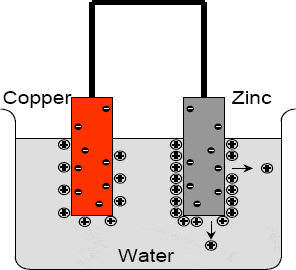
Principle of Fuel Cell
Fuel cells are manufactured in several types that use various electrolytes and fuels. Figure 2.7 shows the schematic of a Hydrogen-Oxygen fuel cell, explaining the basic principle of operation of the fuel cell:

Schematic of Hydrogen-Oxygen Fuel Cell
The heart of the fuel cell consists of the basic components of anode, cathode and electrolyte. The two porous electrodes, namely the anode and cathode, are made from nickel and kept immersed in an electrolyte. The porous anode, also called the fuel electrode is in contact with hydrogen (fuel) maintained at a pressure. The hydrogen diffuses across the electrode and bubbles to the opposite electrode. The porous cathode, also called oxidant electrode, is in contact with oxygen maintained at a pressure. The oxygen diffuses across the porous electrode and bubbles across to the opposite electrode through the medium of the electrolyte. The chemical reactions inside the electrolyte produce DC electricity, resulting in a current flow in the external circuit through leads connected to the anode and cathode electrodes. During the process of electricity generation, by products of water, spent fuel and spent oxidant are released by the fuel cell. Fuel cells are ideal where hydrogen-rich fuel is readily available.
Fuel cells can be classified into various categories based on the following parameters.
- Type of fuel and oxidant used
- Type of Electrolyte used – Acid or alkali
- Usage method of fuel – Direct or Indirect
- Operating temperature
- Low ( 0-150°C)
- Medium (150-250°C)
- High (550-800°C)
- Ultra High ( 800-1100°C)
- Power Rating
- Low power ( Less than 100kw)
- Medium power ( 100kw to 500kw)
- High power ( 500kw and above)
Similar to the case of storage batteries, fuel cells are connected in parallel and series configurations to obtain the requisite current and voltage ratings. The fuel cell generator has additional building blocks of the fuel processor and a power conditioning device as shown in the block diagram in Figure 2.8. The fuel processor processes the basic input fuel into hydrogen-rich input for the next stage, namely the power section. The power produced by the fuel cell is DC which is then converted into AC power and then output from the cell.
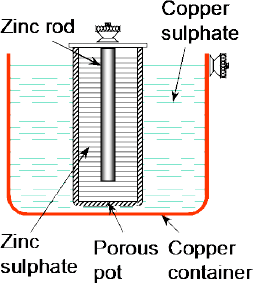
Block diagram of Fuel cell generator
Table 2.2 shows the various electrolytes used in fuel cells and their operating temperatures:
Fuel electrolytes and operating temperatures
| Electrolyte | Operating Temperature |
| Solid Polymer | 80 °C |
| Alkali | 100 °C |
| Phosphoric Acid | 200 °C |
| Molten Carbonate | 650 °C |
| Solid Oxide | 1000 °C |
Fuel cells can be classified based on the operating temperature as shown in Table 2.3.
Fuel cell Temperature Classes
| Temperature Class | Temperature °C |
Electrolyte | Electrodes | Fuel | Oxidant |
| Low Temperature | 0 – 150 | KOH, H2SO4 | Porous carbon with metal | Hydrogen | Oxygen, Air |
| Medium ~ High | 150 – 250 | KOH NaOH |
Anode – Nickel, Pd Cathode – Ni, NiO |
Hydrogen Reforming gas, Coal gas |
Oxygen, Air |
| High | 550 – 800 | Carbonate metals and MgO paste | Nickel, Cobalt, Copper, Silver | Hydrogen, Carbon monoxide, Hydrocarbons |
Oxygen, Air |
| Ultra High | 800 – 1100 | Solid ZrO with CaO | Pt | Hydrogen, Carbon monoxide, Hydrocarbons |
Air |
Table 2.4 shows the various gas fuels used in fuel cells and the respective voltages generated by the cells:
Fuel type and voltage generated
| Fuel | Voltage at 25 °C |
| Carbon | 1.02 |
| Ethane | 1.06 |
| Butane | 1.08 |
| Propane | 1.09 |
| Ethylene | 1.15 |
| Ammonia | 1.17 |
| Methanol | 1.21 |
| Glycol | 1.22 |
| Hydrogen | 1.23 |
Figure 2.9 shows the efficiency vs current density characteristics of a fuel cell. As can be seen, the higher the current density, the lower the efficiency of the fuel cell.
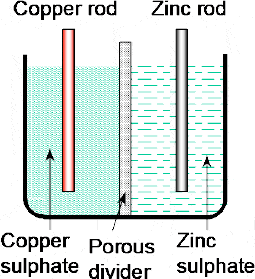
Fuel Cell – Efficiency vs Current density (A/m2)
Figure 2.10 shows the current density vs voltage and current density vs power density characteristics of a fuel cell.

Current Density vs Voltage, Power density of Fuel cell
The cell voltage reduces with an increase in the current density (A/m2) whereas the power density (Kw/m2) increases with an increase in the current density.
Comparison of GT, DG and Fuel Cell based Power Systems
Comparison of GT, DG and Fuel cell Technologies
| Power System | Advantages | Disadvantages |
| Gas Turbine | Low Emission High Reliability Cooling not required Exhaust waste heat available for recuperation |
Requires high pressure gas Poor efficiency at low loading Output falls as ambient temperature rises |
| Diesel Engine | High power efficiency with part loading Fast startup Comparatively low investment cost Local overhauling feasible |
Relatively high emissions High maintenance costs Requires cooling arrangements High noise levels |
| Fuel Cells | Low emissions Low noise levels High efficiency over wide load range Modular design |
High costs Low durability and power density |
2.2 UPS for critical loads and various available options
A static UPS can be defined as an uninterruptible power system which is intended for providing quality and continuity of power to loads, for a specified period of time in the event of a mains failure. It generally refers to systems that can provide a reliable alternative source of electric power, which will prevent total power failure to an equipment or system. Sources that provide both DC and AC power are used in many industrial applications and qualify to be referred to as Uninterrupted Power Systems. However, in this manual, the term UPS will be used in the context of a source of AC power.
UPS Systems consist of the following essential components:
- A normal source of power, usually mains power
- A backup source to provide power to the load during short time mains power failure (the actual time can vary based on the type of UPS)
- A standby source to feed power for extended duration of mains power failure
- An optional power-conditioning device
- Isolation device to isolate the load and mains (preferred)
- Device for switching between normal and emergency power (only applicable for certain types of systems)
- A bypass circuit used in the event of failure or maintenance of the UPS system
Static and Rotary Options
UPS systems are commonly classified into the following categories:
- Static (fully electronic) UPS with battery as standby power source
- Passive (Offline)
- Double conversion (Online)
- Line interactive
- Rotary or Electro Mechanical (EM) UPS systems
- Short time ride through using inertia (flywheel)
- Engine powered no-break systems for long period backup
- Advanced systems providing Power Quality improvements
- Hybrid UPS systems containing both rotary and static system components
2.2.1 Static UPS systems
A static UPS system has a battery as the main back up source. A rectifier converts the mains supply to DC and the battery is connected to this DC bus. An inverter synthesizes an approximately sinusoidal output from the DC voltage and feeds the critical loads. Since the battery capacity is normally adequate for limited periods only, it is usual to provide some other back up power source such as an emergency engine generator to handle prolonged outages.
However, there are many applications where use of static UPS systems may not be appropriate and may call for other forms of UPS systems. The rotary UPS system can provide a viable alternative in these cases. Such systems are also sometimes referred to as Electro Mechanical or kinetic UPS systems.
A static UPS system is one way of ensuring uninterrupted power to critical loads. While rotary type UPS systems are better suited to feed critical loads in medium voltage systems usually consisting of large capacity drives, static UPS systems are widely used for feeding lower capacity, low voltage loads. Instrumentation equipment, process control computers, general computing equipment, critical lubrication drives and emergency lighting are some of the loads which are commonly fed by static UPS systems. The general configuration of static UPS systems and the different subtypes of these systems are discussed below; also discussed are the differences in their operation and relative merits.
Besides ensuring continuity of power, UPS systems are also useful in improving power quality to critical loads, mainly due to the fact that larger capacity systems isolate the loads from the mains supply even during normal conditions. Another factor to be considered is that static UPS systems are prone to component failures just like any other electronic system. Critical loads fed by an UPS will be affected in the event of component failures, and providing redundant modules is one way of improving the reliability of UPS systems further.
General configuration
Any static UPS system consists of few essential and optional subsystems regardless of the type involved. Figure 2.11 shows a general configuration applicable to any static UPS system.
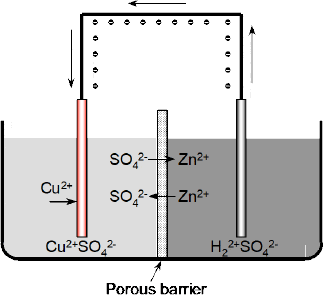
Static UPS-General configuration
The following are the component subsystems of a typical static UPS system:
- A backup source (storage battery)
- Rectifier (also used as charger for battery)
- DC bus (or some form of link between rectifier output, battery and input of inverter)
- Inverter for synthesis of AC output from DC
- Mains power supply, regulation and conditioning
- Static transfer switch or static bypass (optional for some configurations)
- Maintenance bypass (optional)
- Isolation transformer (optional)
A storage battery is the power source used in a static UPS system for ensuring continuity to the loads that are fed by it. The storage battery is a critical component of any UPS system and often the main reason of failure of UPS derived supplies. Their design, operation and maintenance are very critical to reliability and should receive due attention.
The rectifier receives power from the mains and converts it into DC. When mains power is available, the rectifier supplies a charging current to the storage battery. The rectifier should be configured so as to cause minimum amount of ripples on the DC side and to ensure a good power factor in the mains AC system. Uncontrolled diode bridge rectifier is superior from this point of view. However, other components will be required for the control of charging current flowing to the battery. Certain types of batteries need ripple free charging current as ripples can cause damage to the battery. The rectifier needs to be provided with proper filters to ensure ripple-free output.
The DC bus is the connection between the output of the rectifier, the storage battery and the input to the inverter. In small UPS systems, there may be no such physical bus except the wiring terminating in a common set of terminals. The battery will maintain the voltage of the DC bus when mains power fails (and consequently the rectifier output is no longer available). The voltage however, keeps falling as the battery continues to discharge. Usually some form of low DC voltage alarm is provided to indicate that the battery is nearing its full output. Further discharging of the battery will result in the operation of a cut-out, which trips the inverter to avoid over-discharging of the battery.
Inverter subsystem converts the DC voltage of the DC bus to a synthesized AC output. While the low capacity static inverters generally use the partial square or trapezoidal waveform, the higher capacity units provide pulse-width modulated AC output.
Mains power supply is received through some form of switching device, usually a molded case circuit breaker (MCCB) and in lower rated units, a miniature circuit breaker (MCB) or a rotary switch, in combination with input fuses. It is usual to provide surge protection devices of appropriate rating on the input side to protect the sensitive components of the UPS system from damage in the event of a surge originating from the supply system. Similarly, the UPS output is protected by fuses/MCB/MCCBs with overload protectors and surge protection devices to protect the inverter components from any over voltages transmitted from the load side. Where very wide fluctuations of input voltage can be expected, a voltage-regulating device such as a servo-stabilizer (not shown in the figure) may be interposed between the AC mains and the inverter. This is useful in two ways. One is to keep the battery from going into the discharge mode at low mains voltage conditions (sustained sag) by boosting the voltage to near-rated input value. The other is to regulate the output voltage of the UPS when mains power is directly connected to the loads.
The static switch transfers the load automatically from mains power to inverter or visa versa, the exact nature being dependent on the type of the UPS system. In some of the UPS types, static switch is an optional component, whereas in others it is an essential part of the UPS system. Since the loads can get directly connected to the mains under certain situations, it is desirable to have some form of power conditioning devices such as the voltage regulator mentioned in the last paragraph. Another power conditioning component is a filter to control the communication of noise and harmonics from the power mains to the loads fed by UPS.
The transfer of power from one source to the other source can be performed by the following methods:
- Asynchronous transfer: Load power transfer from one source to another when the sources are not in synchronism
- Synchronous transfer: Load power transfer when the power sources are in synchronism with each other
The time duration between the initiation of transfer from one source to the instant at which the load is completely transferred to the other source is called transfer time. An UPS switch is used to disconnect or connect the different parts of the UPS and can be utilized for connecting the load either to mains power or to UPS power. In figure 2.12a, the UPS switches are used for transferring load from mains to UPS and visa versa. Figure 2.12b shows the UPS switch used as a connecting/ disconnecting device between the UPS and the load.

UPS switch for transfer of load

UPS switch for connection/disconnection of load
An UPS transfer switch comprises of a combination of two or more UPS switches for transferring load from one source to the other. Transfer switches are used for transferring the load from the UPS to the mains supply when:
- The peak load exceeds the UPS rating
- There is a fault in the UPS
- There are surges and transients in the load current
- The UPS is taken for maintenance
Walk-in circuit provision is given in a UPS to prevent a sudden shock load to the power system during switching on the UPS. The walk-in circuit provides gradual loading of the power system by the UPS when switching on the UPS.
A maintenance bypass is another optional component. This consists of a manually operated external switch which bypasses the UPS and directly feeds the loads. This is useful for undertaking maintenance of the UPS system and for carrying out repairs to any of the UPS subsystems in the event of a failure. The power supply to maintenance bypass may be obtained from an altogether different source so that it will be useful in the event of any failure of mains power related components. An isolation transformer is provided to avoid surges and common mode noise from being conveyed to the loads.
The general efficiency of the static UPS in relation to the capacity is illustrated in Figure 2.13.
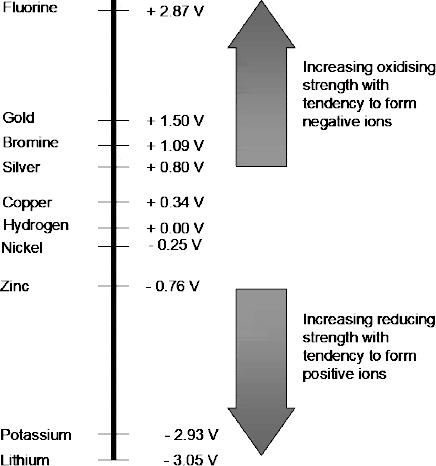
UPS efficiency in relation to Capacity (kVA)
Types of Static UPS Systems
Three basic types of static UPS systems are generally in use:
- Passive
- Line interactive
- Double conversion
The above nomenclature is based on the standard IEC-62040-3, which has suggested the term ‘passive’ in place of ‘offline’ and ‘double conversion’ instead of ‘online’, which were in use earlier.
Passive UPS
The schematic arrangement of a passive UPS is shown in Figure 2.14.

Static UPS-Passive type
The arrow marked as ‘Primary’ in this diagram represents the power flow under normal (mains power available) condition. The arrow with a dotted line marked as ‘standby’ shows the direction of power flow under mains failure condition.
As can be seen, all the component units of the general configuration shown in Figure 2.10 are present in the passive type UPS unit. When mains power is available, the load is supplied directly from the mains through the static switch. The rectifier simply acts as a battery charger and keeps the battery charged. The inverter is idle under this condition. When mains power is interrupted, the static switch changes over the load to the inverter with a small delay. The power in this mode is drawn from the battery and the inverter generates the AC output for the critical loads. This continues till mains power is restored either from the normal source or any other emergency standby source. When the supply is restored, the static switch connects the load back to the mains, again with a similar delay. If the supply is not restored, the battery operates until the end of its discharge cycle and the low voltage cutout operates and shuts down the inverter.
Since the static switch initiates the changeover only after sensing the failure (or restoration) of mains power, there is a definite delay involved in the changeover. However, the time delay is very short and is restricted to a value of 8 to 10 milliseconds by proper design of the static switch. It therefore follows that the loads fed by this type of UPS must be able to tolerate the break of supply for a period higher than the time taken by the static switch to affect the changeover.
In some of the cheaper designs, the static switch is replaced by a mechanical relay, and the speed of changeover can become higher than what is obtainable from a static switch. This point needs attention while selecting the UPS.
The main advantage claimed for this design is its cost effectiveness. The rectifier is sized only for the battery current. The inverter is sized only for the short duration of operation. These factors enable the component ratings to be optimized. Another indirect benefit is that the losses in the inverter are limited to the duration of its operation and are therefore minimal.
Offline UPS systems are generally restricted to lower capacities (2 kVA or less) of UPS systems. This UPS is unsuitable for use in systems where the break in output caused by switch operation is not acceptable. It may also be noted that since the loads are directly fed from mains power (i.e. for most of the time), power quality improvements are limited to those possible with the regulation and conditioning scheme of the UPS. Problems such as frequency drift etc. cannot therefore be corrected. In some of the UPS designs, the changeover to battery source is done not just for mains failure conditions but also when the supply parameters such as voltage and frequency drift beyond set limits. This can however pose a problem, since such a design can:
- Cause the battery to be subjected to frequent discharge-charge cycles, thus reducing its useful life
- Can result in lower backup time when there is an actual mains failure, if it is preceded by a period of unstable voltage and frequency, and the battery gets partially discharged as a result.
Line Interactive UPS
This type of UPS is similar to the passive type, except that the static switch is positioned differently and is not involved in the switching of load from mains to inverter. Figure 2.15 shows the schematic configuration of the line interactive type of UPS.

Static UPS-Line interactive type
In this type of UPS, the static switch connects the mains supply to the load when it is present, but the inverter module is also connected to the load in parallel. When mains power supply is present, the inverter module behaves like a rectifier and supplies charging power to the battery. When the mains power fails, the inverter module starts operation as an inverter and power flow direction is reversed. Under this condition, the battery supplies the back up power for the loads. When the inverter starts supplying power to the load, the static switch opens and prevents the flow of power back to the mains. When mains power is restored, the above steps are reversed. The delay that normally occurs in the case of the passive type UPS is thus minimized, since the reversal of power flow can be carried out much faster and does not depend on the switch operation. However, this type is also limited to smaller ratings only.
Double Conversion UPS
This type of configuration is used in most of the static UPS systems and can be rated from as low as 1 kVA to several hundred-kVA of output power. The scheme of a double conversion UPS is shown in Figure 2.16.

Static UPS-Double conversion type
As can be seen from Figure 2.16, the normal or primary mode of power flow is from mains power to the rectifier to the inverter and on to the loads. The rectifier supplies the power required for the loads and also charges the battery in this condition. When the mains power fails, the rectifier output stops, but the battery maintains the DC bus voltage. Thus, the power required for the loads is now supplied by the battery. Since the inverter is functioning in both of these modes, there is no break of supply at the output of the UPS for mains power failure condition. When mains power is restored, the UPS goes to the same status as it was prior to the failure. The only difference perhaps, is the higher charging current that will have to be supplied to the battery to quickly restore it to its fully charged condition.
Most designs also provide a static switch merely as a means of automatic transfer of the loads from inverter to mains in the case of a failure of the inverter module. This is however an abnormal condition, and the resulting delay and break of power supply at the output will have to be accepted. It should be noted here that the output is normally that of the inverter whether mains power is available or not. This has distinct benefits for the output power quality. Firstly, all harmonics, surges and noise generally get absorbed before the inverter and do not get reflected at the output. The second is that the inverter can operate at its own frequency independent of the mains power and can maintain constant frequency at its output.
The disadvantages of the double conversion UPS are its higher cost and increased power losses. The cost is higher because the rectifier will have to be rated for the full load current as well as the battery charging current and the inverter has to be rated for continuous operation. These requirements call for components of higher current rating. The losses in this design are also higher because the inverter has to operate continuously unlike the passive UPS, whereas the inverter comes into operation only during mains failure. Consequently, the inverter tends to get heated and it is usual to provide cooling fans for ventilation within the UPS system so that the temperature of the semiconductor devices does not become too high. Operation of cooling fans needs to be monitored since stoppage of cooling fans can result in failure of semiconductor devices.
In some designs of double conversion UPS, particularly in the lower output range, the static switch is omitted. This results in reduction of UPS cost but carries a risk of loss of power should there be a failure of inverter. The scheme of such an UPS is shown in Figure 2.17.

Static UPS-Double conversion type without static switch
The following points need attention in all the above UPS configurations. The standby batteries are normally sized for providing backup for short periods only. The normal backup period can vary between 15 minutes to 1 hour. In case higher duration of power outages are expected, an appropriate standby power source must be provided so that power supply to UPS can be restored before the battery becomes fully discharged. In case this is not possible, UPS power must be used for ensuring safe and orderly shutdown of equipment in the event of a mains power failure.
Furthermore, the UPS batteries must be charged at an adequately high rate to ensure that they are quickly restored to a fully charged state after a power interruption and subsequent restoration. This is to make sure that the batteries can provide sufficient backup time in the event of a subsequent power failure.
2.2.2 Rotary UPS systems
A rotary UPS system may or may not use an engine. A flywheel is a common component of most types of rotary UPS systems. The main function of a flywheel in a rotary system is to store energy that can be used to maintain power for brief periods of outage, or more commonly, sag conditions in the power system. In a system which does not use an engine for standby power, the flywheel is the sole source of energy for standby purpose. Since the quantum of energy which can be stored in a flywheel is restricted, such a system can be used where the duration of backup required is of the order of a fraction of a second to a few seconds at best. This type of system is called a flywheel ride-through system (see Figure 2.18). While this works well for sag conditions, its usefulness for an interruption is limited because of the need to re-synchronize when power supply resumes. This will call for a more elaborate circuitry.

Flywheel ride through system-Single machine configuration
The salient features of a system of this type are as follows. Under normal conditions, energy is stored in the flywheel which is kept rotating by the machine acting as a motor. During a sag condition, the voltage output is maintained using the energy supplied by the flywheel. The machine now acts as a generator and maintains quality of supply to the essential loads.
It is however possible and sometimes advantageous to use two machines: one being a motor and the other a generator. Figure 2.19 illustrates such an option:

Flywheel ride through system-Dual machine configuration
In the case of dual machine option, the mains supply is isolated from the critical loads and under normal conditions, the voltage variations, surges and other disturbances such as harmonics occurring in the mains do not pass to the essential loads system. In the case of a single machine configuration, the mains supply is directly connected to the essential loads and they are exposed to all the power quality problems present in the mains. Also, here, re-synchronizing of system output with external supply on resumption of power is not an issue.
The main disadvantage of both these configurations is however, the limited duration of back-up available from such a system. When the mains power fails, the frequency of the system has to be maintained by the flywheel, which rapidly slows down. Thus, it cannot maintain a fixed frequency beyond a very small duration. There is also the possibility of the flywheel’s power reserve flowing back into the system, which makes the slowing down even more rapid. This type of system therefore is of very limited use beyond providing voltage support in the event of a sag. With certain improvements, the time of back-up possible with this system can be increased. Other types of systems using stored energy from a compressed air reservoir or a magnetic coil constructed using high/low temperature super-conductor windings (in place of flywheel) are also available.
The other type of rotary UPS system, where an engine acting as a prime mover providing the back-up power is of much better practical use. Such systems are similar to the flywheel type rotary system discussed above, except that an engine is connected to the same shaft through a clutch. The role of the flywheel is limited to maintaining the power output during the starting period of the engine. Thereafter, the engine takes up the load. Quick starting of the engine is ensured by continuous operation of engine lubrication system and external heating of lubricant when the engine is idle.
In some of the designs, the engine starting is also completed using the energy of the flywheel. Such systems use an electromagnetic clutch, which normally keeps the engine isolated but couples it only when there is a mains failure. In other designs, the engine uses a battery assisted DC motor, hydraulic accumulator or compressed air motor for starting. In this design, the engine is connected to the shaft through a freewheel type of clutch. Only when the engine acts as the prime mover, the clutch allows the engine to drive the generator shaft. The engine shaft otherwise does not rotate. Both single-machine and two-machine options are possible in this type of rotary UPS (see Figure 2.20).

Rotary UPS system-Single machine configuration
In this example, a single machine is used both as a motor and generator. The engine is connected through a freewheel clutch and is started using an external starting device. Normally, when mains power is available, the machine runs as a synchronous motor on the supply. When there is a mains failure, the flywheel drives the system and maintains supply to the essential loads. Simultaneously, the mains side breaker will open to prevent flow of power back from the UPS into the system and the engine gets a starting impulse. Once the engine starts, loads are quickly taken over by it and the flywheel goes back to its normal speed and keeps spinning. A few points may be noted in this arrangement.
There is no break of power to critical loads. The power from the machine simply reverses direction. It goes from the status of a motor drawing power from the system, to being a generator, supplying power to the system. When running as a motor, it is possible to run the machine as a synchronous condenser (motor with over-excitation), thus compensating for the low power factor.
The disadvantage is that the essential loads are normally fed by the mains and so power quality problems including frequency variations, harmonics etc. will pass on to these loads. This problem can be addressed by the two-machine rotary UPS configuration, which is shown in Figure 2.21.

Rotary UPS system of two-machine configuration
In this case, there are two machines coupled through a common shaft to a flywheel. One machine acts as a motor and the other as a generator supplying to critical loads. The first machine can also act as a generator in the event of a mains failure, but feeds a set of essential loads separately. The essential loads are thus directly connected to the mains under normal conditions and are therefore exposed to any power quality problems that the mains supply is subject to. But the more sensitive loads (denoted here as critical loads) are isolated under all conditions from the mains and are supplied directly by the generator: they are therefore immune to all power quality problems arising from the supply (except, naturally, variations of frequency). The behavior of the UPS is otherwise similar to the single machine configuration.
A few points need to be noted here. On mains failure, the switch or breaker, which connects the UPS to mains, should be opened. This is to prevent reverse flow of power into the system. When mains power is restored, re-synchronization to the mains will be necessary to restore the system to the original state. In the case of the two-machine configuration, the generator should be sized so that the starting of motors in the critical loads section does not cause any problem because of the relatively high generator impedance (compared to the mains system impedance). This will cause appreciable voltage sag during starting of motors in the critical system and may affect the operation of the other critical loads. Some form of fast acting voltage regulation will need to be provided to overcome this problem.
The rotary type of UPS with a back-up engine has several advantages. They are as follows:
The most important is the avoidance of batteries as a back-up source. Batteries need constant attention and maintenance besides periodic replacements, thereby entailing recurring expenditure. The second is the extended back-up time that is possible. Batteries can provide back-up power for a limited duration only (the usual practice being to provide power between 15 minutes to an hour). This is essential if the battery capacity and size are to be kept within reasonable limits. In the case of the rotary UPS, the engine can provide back-up power for a much longer duration, which is an advantage if long periods of outage are expected.
It is possible to use the rotary system for very high capacities and for medium voltage drives. Static UPS systems have restrictions of voltage and capacity if the cost of the system and battery requirements have to be kept within reasonable limits. Thus, rotary UPS systems are used often in industrial plants where the quantum of critical and emergency loads is substantial. The short time overload capability of the rotary systems is much better in comparison to the static UPS systems and they can easily absorb load current fluctuations.
The two-machine configuration of rotary UPS effectively isolates the critical loads from mains and can thereby improve power quality to critical loads effectively. In addition, they can be used for providing some degree of compensation for the low power factor. There are some disadvantages to these systems as well. One such disadvantage is that of the low operating efficiency, especially, with the use of two machines in the system. Regular maintenance of rotating components is also essential to avoid failures due to friction and fatigue. Acoustic noise levels will be considerably greater than the static systems, much more so when the engine is operating during mains failure conditions.
Advanced Rotary UPS Systems
Advanced features are available in some of the variants of rotary UPS systems manufactured by specific vendors. Some of these use an integrated flywheel, motor and generator as a monolithic block. Magnetic bearings are also used in some of the designs to reduce frictional losses and prolong the back-up period of the flywheel. That is, by reducing the friction, the rate of fall of speed of the flywheel under mains failure conditions is reduced, thereby slowing down the fall of frequency and increasing the back-up time. Some of the designs use a DC motor and inverter for keeping the frequency constant and independent of the speed of the flywheel. Others use power electronics to produce harmonic cancellation waveforms or dynamic power factor improvement by varying the VAR component. There are designs where slip frequency AC is used to feed the generator’s field system so that a fall in speed is compensated and the output frequency remains constant. Two of these rotary UPS systems are illustrated in Figures 2.22 and 2.23.

Example of improved type rotary UPS system
In this case, the rotary UPS is based on a flywheel for providing short-term backup. The flywheel is driven by DC motor through a rectifier connected to mains power. Critical loads are directly connected to the mains. When there is mains failure, the static switch opens and the inverter starts supplying critical loads. The energy for the loads is supplied through the flywheel, with the DC machine going into the generator mode. The AC power for critical loads is now obtained through the inverter. The frequency is thus independent of the speed of the flywheel. The back-up engine starts simultaneously using a battery driven starter motor and an auto changeover scheme changes over the supply onto the standby generator. The essential loads now start receiving supply (but there is a small duration of power interruption). The static switch now switches the critical loads to the back-up generator, with either minimum (less than a cycle) or no interruption. A similar concept is sometimes used in flywheel ride-through systems where the use of a combination of DC machine and inverter can compensate for speed drop of the flywheel and thus prolong the output for a period of several seconds.

Another example of improved type rotary UPS system
In this example, the generator field is supplied through an inverter with the frequency being varied continuously. The system is otherwise similar to the standard two-machine configuration. The advantage of supplying the generator field through the inverter is the ability to maintain constant frequency during the intermediate condition of flywheel supplying the power immediately following the failure of mains supply. That is, by supplying the field winding with slip frequency AC power from the inverter, a constant frequency output can be obtained. It is theoretically possible to do such a correction even when the mains is present but has frequency problems. Thus, the scheme provides improved power quality to critical loads.
2.2.3 Other types of UPS Systems
There are also a few other variants of these types available on the market: the salient aspects of these variants are given below:
- Passive UPS with Ferro-resonant output transformer
- Hybrid passive UPS system
- UPS with Ferro-resonant Transformer
Some UPS systems use a 3-winding Ferro-resonant transformer at the UPS output. Two of the windings are for input (one from mains and the other from the inverter) with a common output winding (see Figure 2.24).

Static UPS with Ferro-resonant transformer
This type is similar in concept to passive UPS systems. When mains power is available, loads are fed directly from the mains supply through the static switch and the Ferro-resonant transformer. When the mains power fails, the static switch opens and the inverter takes up the load through the transformer. The Ferro-resonant transformer acts as a filter to the output waveform and can also regulate slow voltage changes. Under certain conditions it can minimize the break of output when the mains fail and the inverter takes up the load. (It should however be noted here that, in the case of mains failure due to short circuits, the voltage output can quickly collapse and the interruption of output voltage may exceed the normal passive type of UPS). Other problems associated with this type of UPS are:
- Unstable output when load has power factor correction capacitors
- Low efficiency at part loads
- May interfere with fuse protection
- May call for surge protection on output side
Use of this type is not therefore very common.
Hybrid Passive UPS
Hybrid UPS is also a variant of the passive type of UPS. The schematic arrangement of the passive UPS is illustrated in Figure 2.25.

Schematic diagram of hybrid passive UPS
Like the passive UPS, here too the load is directly connected to mains power when it is present and switched to the battery source when the mains power fails. However, there are two major differences. There is no static switch in this scheme. Instead, a rectifier converts the main supply to DC and feeds it through a combiner to the load through the inverter. The second difference is that the inverter is always in circuit. It either receives its input from the mains supply converted to DC by the rectifier or from the battery through a regulator, which controls the output of the battery. When mains power fails, the battery voltage continues to supply the loads through the inverter. By proper setting of the regulator, the delay in switching between mains and battery can be eliminated. A separate rectifier fed from the mains circuit keeps the battery under charging when mains voltage is present.
In many respects, the UPS behaves like a double conversion UPS except that there are two different rectifiers, one for charging the battery and another for supplying the load. The obvious disadvantage is that any failure of inverter module can cause the failure of UPS output.
Redundant UPS Configuration
UPS systems are also prone to failure just like any other electronic equipment, particularly in the beginning of the life cycle. Moreover, failures can also be caused by the problems of the back-up battery. Since UPS systems are used to supply power to critical loads, interruptions arising out of such failures are naturally not acceptable. One way of overcoming the interruptions due to UPS failures is to provide systems with redundant modules. Figure 2.26 shows a redundant UPS configuration using double conversion UPS modules:

Redundant UPS configuration
This scheme is usually referred to as N+1 redundant configuration. This means that the design of the system is achieved so that N modules can supply the total power requirement by sharing the load equally. But, the configuration provides one additional parallel module so that the total number of modules is N+1. Under normal conditions, all modules share the load equally with a little extra capacity to spare. If one of the modules were to fail, the rest of the N modules will continue to operate sharing the load and continuing to work within their rated capacity. It may also be noted from the scheme that each module has its own back-up battery and thus redundancy exists not only for the electronic components of the modules, but also for the battery. In addition, a static switch is provided and is fed from a separate source so that in the event of simultaneous failure of more than one module, the load can be switched to the alternate supply through the static switch.
2.2.4 Data and specifications required for the procurement of UPS system
The specification of the battery based electronic UPS should incorporate the following:
- Input kVA rating
- Input current limit
- Peak inrush current during switch on
- Walk in circuitry option
- Output kVA rating
- Output voltage regulation
- Output frequency tolerance
- Output frequency slew rate
- Total harmonic distortion: Input current
- Total harmonic distortion: Output current
- Over load capacity
- Phase displacement tolerance between phases of the output voltage
- Voltage unbalance between output phase voltages
- Efficiency
- Noise level
Load Data:
- List of loads connected to UPS
- Total power required by existing loads:
- Single phase loads:
- Voltage, freq, pf, Kva
- Peak inrush current – Magnitude and duration
- Crest factor
- Three phase loads:
- Voltage, freq, pf, Kva
- Peak inrush current – Magnitude and duration
- Crest factor
- Neutral requirement
- Grounded/ Ungrounded system
- Single phase loads:
- Type of loads connected to UPS:
- Lighting
- Computer systems
- Motor loads
- Instrumentation loads
- Air conditioning
- Other types
- Total power required by estimated future loads:
- Single phase loads: Voltage, freq, pf, Kva
- Three phase loads: Voltage, freq, pf, Kva
- Other characteristics of loads:
- Balanced/Unbalanced loads
- Linear/Non linear loads
- Continuous duty/Intermitted duty
- Special grounding requirements
Power Data:
- Storage energy time:
- Stored energy usage time
- Stored energy restoration time
- Mains power specifications:
- Single phase: Voltage, freq, pf, Kva
- Three phase: Voltage, freq, pf, Kva
- With neutral/Without neutral
- Grounded/Ungrounded mains system
- Voltage regulation
- Transient voltages
- Harmonics
- Availability of alternative power source
- Frequency and duration of mains power failures
- Available fault current
Battery Data:
- Battery characteristics:
- Battery type and storage energy duration
- Restoration energy duration
- End of discharge voltage
- Rated current at nominal voltage
- Maximum current at end of discharge voltage
Other Requirements:
- Ambient temperature range
- Environment conditions: Heat, moisture, dust, seismic condition, fumes, salt air, chemicals etc
- Site condition: Vibration, shock, accessibility
- Space, weight constraints
- Local/Remote monitoring and control requirements
- Grounding requirements
- Safety considerations
- Noise levels
- Heat produced during operation
- Type of cooling for UPS
Alarm Data:
- Loss of input AC voltage
- Ground fault
- Low output voltage due to battery discharge: charger malfunction
- End of discharge to indicate further discharge will damage the batteries
- High DC output alarm to indicate charging voltage exceeds permissible threshold level
- Loss of cooling by using thermostat or air flow switch
- Low battery shutdown
2.2.5 Maintenance of UPS
UPS maintenance should include the following:
- Maintenance of trained competent personnel
- Maintaining of maintenance, repair log register
- Maintenance of alarm log, downtime
- Battery maintenance schedule and log register
- Air filter cleaning
- Maintenance of ventilation condition
2.3 Battery as source: types and their pros and cons
Battery is the energy storage device used for UPS applications. Energy is stored in the battery in the form of chemical energy during charging and is converted back to electrical energy during the discharge phase. The direct current of the battery is converted to alternating current by the UPS and delivered to the loads. The most commonly used types of batteries in UPS are:
- Lead acid battery (Lead Calcium and Lead Antimony)
- Nickel Cadmium battery
Figure 2.27 shows the types of batteries and the various versions in which they are available:

Battery Types
2.3.1 Lead acid battery
Lead acid batteries use lead electrodes and sulphuric acid as the electrolyte. Figure 2.28 shows the schematic of the construction of a lead acid battery.

Schematic of Lead acid battery
Lead acid batteries consist of a positive electrode plate made of ‘lead peroxide’ and a negative plate made of ‘sponge lead’ immersed in an electrolyte of sulphuric acid. There are two types of lead acid batteries, namely ‘lead calcium’ type and ‘lead antimony’ type. Lead calcium batteries are not suitable for charge/discharge cycling applications and can undergo 30 to 50 deep discharges over their life. Lead Antimony batteries can tolerate up to 300 to 500 deep discharge cycles. Nickel Cadmium batteries have electrodes made of nickel and cadmium, and potassium hydroxide as the electrolyte. Both Lead acid and Nickel Cadmium type batteries are designed both in flooded and valve regulated versions.
Figure 2.29 shows the construction details of a typical flooded cell battery:

Construction of a typical flooded cell battery
Flooded cell batteries have a liquid electrolyte like sulphuric acid. Valve regulated type or maintenance free batteries as they are called, do not have free liquid electrolyte and do not require a specially designed room with dedicated temperature control, dedicated exhaust and ventilation system or hazardous area equipment, and are less maintenance intensive. The cells can also be oriented in any direction without problems of spillage of electrolyte. The electrolyte in a VRLA sealed battery is made immobilized using the following technologies:
- AGM – Absorbed glass matte technology
- Gelled electrolyte technology
- Oxygen recombination technology
In an AGM battery, the electrolyte is completely absorbed in a glass matte (AGM) and in a Gel cell, the electrolyte is in a gel form. Valve regulated batteries are smaller in size compared with flooded cell batteries. Typically, an AGM battery has approximately 40% less volume of electrolyte than a flooded cell and a Gel cell has about 15% less volume of electrolyte. The Valve regulated lead acid batteries also use re-combination technology whereby the gases evolved during charging operation re-combine to form water again. This eliminates the need for adding water as is required for flooded cell batteries.
The capacity of the battery is stipulated in terms of ampere hours (Ah). It is the purpose of the battery to provide a certain amount of current for a certain duration of time. A 200 Ah battery can supply a current of 25 amps for eight hours. However, if the rate of discharge is increased, the duration of current delivery will be reduced more than proportionately as depicted in Figure 2.30.

Battery capacity in relation to discharge rate
Therefore, battery capacity is a function of the discharge rate and the operating temperature. Battery capacity is mentioned in conjunction with the discharge rate and end of discharge voltage.
For a lead acid battery, the relation between the specific gravity and the amount of charge is given in Table 2.6.
Relation between specific gravity and amount of charge
| Specific Gravity | 1.12 | 1.16 | 1.20 | 1.24 | 1.28 |
| Amount of Charge | 0 | 25% | 50% | 75% | 100% |
The life of the battery depends on many factors, such as:
- Number of charge: discharge cycles
- Rate of charging: high rate of charging reduces life
- Over charging
- Depth of discharge
- Ripple content present in the current supplied by the charger
- Float voltage: Appropriate float voltage should be provided for the batteries in line with the manufacturer’s recommendations. Continuous application of low voltage charging will lead to plate sulphation and on the other hand, high charging voltages will result in problems of over heating, water loss, excessive gassing, warpage of plates and plate active material separation.
- Storage temperature
- Electrolyte level maintenance: Continuous levels below the plate results in plate damage
The life of the battery is affected by its operating temperature. Every 10 Degrees Celsius rise in operating temperature of the battery, reduces the life of the battery by half.
Table 2.7 shows the relation between operating temperature and the life of the battery:
Battery life vs Operating temperature
| Maximum annual average battery temperature (ºC) |
Maximum battery temperature (ºC) |
Reduction in battery life (%) |
| 25 | 50 | 0 |
| 30 | 50 | 30 |
| 35 | 50 | 50 |
| 40 | 50 | 66 |
| 45 | 50 | 75 |
| 50 | 50 | 83 |
Figure 2.31 shows the relation between temperature and battery life and capacity.

Battery temperature vs Battery life and capacity
One of the major causes for battery deterioration is plate sulphation. The causes of sulphation are:
- Frequent discharging below stipulated levels
- Repeated partial charging
- Keeping in discharged condition for long periods of time
- Low level electrolyte
- High specfic gravity of electrolyte
- High temperatures in excess of stipulated limits
2.3.2 Nickel Cadmium Battery
The nickel cadmium battery uses potassium hydroxide as the electrolyte maintained at a specific gravity of 1.2 at 16°C. The anode is made of nickel hydroxide with specially treated graphite and the cathode consists of a mixture of oxides of cadmium and iron. The specific gravity remains more or less constant in the charged and discharged condition of the battery. The average voltage of the battery is 1.2 volts and 1.3 volts when fully charged. The status of charge and discharge of the battery is detected by measurement of the voltage. Table 2.8 illustrates the relationship between the status of charge/discharge and the voltage of the battery.
Relation between status of charge/discharge and battery voltage
| Percentage of Charge | Cell voltage while discharging | Cell voltage while charging |
| 0% | 1.35 | 1 |
| 25% | 1.41 | 1.1 |
| 50% | 1.45 | 1.18 |
| 75% | 1.7 | 1.2 |
| 100% | 1.78 | 1.35 |
The specific gravity of the battery is not affected by charging. When the specific gravity falls below 1.17 at 16°C, the electrolyte should be renewed. Usage of the battery with electrolyte below this specific gravity, results in a rapid reduction in life. While charging a nickel cadmium battery, the type of electrolyte should not be allowed to exceed 46°C. The charging voltage of the charger should be more than 1.85 volts per cell. The battery does not get damaged due to over-charging and hence it is recommended to over-charge to ensure a fully charged battery.
2.3.3 Battery Charging
Following, are the various methods of charging used for the battery:
- Constant voltage charging: A constant voltage of approximately 2.63 volts per cell is applied for charging. Nomally used for 8 hour charging rate.
- Taper charging: Charge volt vs time and current vs time characteristics have a drooping characteristics
- Two rate charging: Two levels of currents are used for charging. Starting current during charge is high. After certain time period, current is reduced to a lower value
- Constant current charging: Current is maintained constant by continuous variation of charging voltage.
The type of charging used depends on the battery type, charging facilities available, service conditions, time available for charging and the number and capacity of the batteries to be charged. Over-charging of batteries results in short life due to plate warpage, plate sulphation, jar damage due to heat and sedimentation of active material. Over-charging can be avoided by
- Regular charging even when not in use (trickle charging)
- Avoiding excessive discharge rates, short circuits and leakage currents
- Maintaining record of charge sequence and electrolyte specific gravity and following a schedule for charging based on service condition
2.3.4 Characteristics of various types of storage batteries
Characteristics of various batteries
| Battery Type | Anode | Cathode | Electrolyte | Volt/ cell | Electrolyte Density | Remarks | ||
| Charged | Discharged | Charged | Discharged | |||||
| Lead Acid | Lead peroxide | Sponge lead | Sulphuric acid | 2.5 | 1.75 | 1.28 | 1.12 | Most widely used Reliable Low cost Discharges over time due to internal leakage |
| Nickel Iron | Steel tube with nickel hydrate and flakes | Iron oxide with iron plate | Potassium hydroxide | 1.2 | 1.2 | 1.2 | 1.2 | Costlier than lead acid battery Can retain charge for longer time Higher energy density Higher current capacity |
| Nickel Cadmium | Nickel oxide | Cadmium | Potassium hydroxide | 1.4 1.2 |
1.1 | 1.2 | 1.2 | Reliable Suited for high temp application Rugged Higher power capacity Long cycle life |
The following factors should be considered and applied to the calculated capacity of a new battery installation:
- Design margin
- Ageing factor
- If the calculated capacity of the battery exceeds the manufacturer’s standard rating, the next standard rating of the manufacturer should be selected
- The battery should be able to accommodate a DC voltage ripple of typically 2% from the rectifier charger without deterioration effects either to battery life or the number of discharge cycles
- The endurance of a cell or battery is stated in terms of the number of full charge/discharge cycles that the cell can sustain during its useful life
- The cell is considered to have reached the end of its useful life when the capacity drops to 80% of the rated capacity
- The data on the number of full charge and discharge cycles that the battery can provide over its life time should be obtained from the battery manufacturer
- The cell containers should be made of high impact, flame retardant plastic material and should be transparent/translucent with markings for minimum and maximum levels
- The cell should be designed with adequate spacing below the plates to:
- Prevent shorting of the plates by the falling deposits and sediments of active plate material over a period of time
- Allow for positive plate growth over the life time of the cell without causing stress to the supports or the container
- Batteries should be provided with flame arrestor type vent plugs and dust caps to avoid fire and explosion hazards
- Acid resistant collection pans should be provided below the battery and the rack to collect acid leaks and spills
- The racks of the battery should preferrably be made of either bolted or welded steel frames and protected against corrosion by acid resistant epoxy paint
- Adequate acid resistant insulation should be provided with the rack portions coming in contact with the cells
Following are the specifications for battery procurement:
- Battery type
- Manufacturer name
- Catalogue reference
- Voltage
- Ampere hour capacity
- Electrolyte density in fully charged condition (at 25°C)
Battery system should be provided with the following monitoring and alarm systems:
- Voltmeter for battery voltage
- High and low battery voltage alarms
- Ammeter for battery current
- Ground fault detector
When batteries are kept in storage for long periods of time in inoperable condition, the batteries tend to get discharged due to internal leakages. Storage of battery in discharged condition results in plate sulphation which, in extreme conditions, is non-repairable. Therefore, batteries intended to be kept under long storage periods should be kept under trickle charging to compensate for the self discharge process.
2.3.5 Battery Maintenance
The life of the battery depends to a great extent on the maintenance performed on the batteries. Following is the inspection check list for flooded lead acid batteries. The frequency of checking the various points in a battery system should be as per recommendations of the manufacturer and the actual operating conditions.
Visual inspection points for batteries:
- General appearance of battery, rack
- Electrolyte spillage
- Electrolyte level
- Jar: Cracks, leaks, distortion
- Plate condition: Warpage, separation of active material
- Excessive heating, gassing
- Terminal posts: Cracks, corrosion, breakage, overheating
- Flame arrestor: Clogging
- Sedimentation at bottom of jar
Electrical inspection points:
- Float voltage
- Pilot cell voltage
- Pilot cell electrolyte specific gravity
- Pilot cell electrolyte temperature
- Individual cell voltage
- Individual cell specific gravity
- Individual cell temperature
- Inter cell connection resistance
General other inspection points:
- Ventilation equipment functioning
- Terminal connection integrity
- Ambient temperature
The internal impedance of the cell should be measured initially during commissioning and later on, on a periodic basis to check for deterioration and assess the healthiness of the battery system. The internal resistance and impedance of the battery are measured using the following methods:
- For measurement of internal resistance, a load is applied to the battery and the step change in voltage and current are recorded:

- The internal impendance of the cell is calculated by passing an AC current of known frequency and amplitude through the battery and measuring the voltage drop across the cell. The internal cell impedance is given by:

The intercell connection resistance measurement for batteries having single post intercell connection and parallel post intercell connection are shown in Figures 2.32 and 2.33 respectively:

Intercell resistance measurement for single post interconnection
The measuring points for a parallel post interconnection are as shown in Figure 2.33 in order to detect interconnection problems below the post inside the battery lid.

Intercell resistance measurement for parallel post interconnection
Battery Problems and Probable Causes
Battery problems and their probable causes
| Battery Problem | Check point, Probable Cause of Problem |
| Battery not taking charging current | Open circuit: Blown fuse, tripped breaker, charger problem |
| Battery taking longer time for charging | Loose connection, Higher resistance in the circuit Low inadequate current setting in charger Charger capacity less than requirement Reversed connections to charger Diluted electrolyte Electrolyte level too low Battery plates sulphated |
| Over heating of battery while charging | Inadequate ventilation Space constraints High charge rate for too long periods |
| Over heating of battery while discharging | High rate of discharge for long period Short between plates |
| Electrolyte low level | Leaking electrolyte, cracked jar Evaporation due to over charging/ discharging |
| Unequal cell voltages | Over charging, discharging Unequal level of electrolyte in all cells Some cells defective Unequal specific gravities of electrolyte in cells |
2.3.6 Battery terms
Design margin: Additional capacity allowance in cell size for unforeseen additions to the power supply system, expected growth rate of the load or less than optimum operating conditions of the battery
Equalizing voltage: A voltage higher than float voltage applied to a battery to correct inequalities in voltage or specific gravity that may develop among cells
Float voltage: A voltage applied to the battery to maintain it in a fully charged condition during normal operation
Full float operation: Operation of a DC system with the charger, battery and load connected in parallel and with the charger supplying the normal DC load plus any self discharge or charging current or both required by the battery
Rated capacity: The ampere hour capacity assigned to a battery by its manufacturer for a given discharge time at a specified electrolyte temperature and specific gravity to a given end of discharge voltage
Flooded cell: A liquid electrolyte filled vented cell in which the products of electrolysis and evaporation are allowed to escape freely to the atmosphere
Battery duty cycle: The load currents supplied by the battery for specified periods, end of voltage, and temperature
3
Configuring Power Distribution Systems for Emergency Loads
3.1 Integrating emergency and critical power needs in distribution networks
While it is desirable to have a totally uninterrupted power supply, it may not be practically viable to install emergency power system to provide 100% power to all the loads in the system, especially in large industrial complexes. Therefore, there is a need to assess the criticality of the power needs of the loads and decide the adequate capacity of emergency power supplies to meet those needs. Some critical loads can tolerate interruption for a brief period, while some loads cannot afford to be without power even for a few milliseconds. Each of these critical loads needs special consideration in the design of the emergency power system for a distribution network.
The following are the considerations in providing a reliable power supply to critical loads:
- What is the duration of power interruption a facility can tolerate? What length of time will cause problems? Equipment such as computers may withstand 5 to 20 milliseconds of interruption of power by their internal capacity. Some very critical mechanical equipment may have other forms of back-up such as overhead tank for lubrication
- How frequently can an interruption occur? Some locations tolerate 1 to 3 power outages annually, but require some additional protection if occurrences total several times a month or 20 to 25 times per year
- Are momentary interruptions acceptable? Is there a need to provide controls for self-restart in case of momentary interruptions?
- What is the cost of the above events in terms of lost revenues? The cost of interruption may justify investment in power and grounding improvements
- Are there any related equipment whose interruption could halt operations even though reliable power is available to specific process equipment? Cooling water and lubrication systems are examples of this case
- Are operations dependent upon communications lines, which also require continuity of electrical power? Should the telephone system be on emergency power?
- Is the ‘back-up’ or ‘alternate’ site operated from the same power source? It is recommended to avoid dependence on common facilities wherever possible (i.e. same power poles, same side of the street, or same underground trench)
- Review to be undertaken along with the local utility representatives on all available options for the normal feeder conditions as well as possible ‘back-up’ feeder availability. Many locations can be served with ‘dual feeder’ capability, which may eliminate expensive long term power support equipment, such as UPS, batteries and engine generators
A proper assessment of these factors will enable determination of the reliability needs of the system and will also throw up solutions to make the facility resilient enough to tackle interruptions when they do occur. It should be remembered that 100% reliability in every case is not a must.
The next step is to plan for minimizing the duration of interruptions when they do occur. This can take the form of:
- Providing measures such as auto reclosure of circuits so that transient faults do not result in lengthy interruptions
- Providing redundancy in design so that a single failure does not result in total disruption. This can include redundant feeders or sources as applicable
- Providing automation along with redundancy so that restoration takes place independent of human action
- Providing no-break take over systems for DC and AC power
3.1.1 Redundancy and automation
Redundancy is one of the main measures to ensure reliability. Redundancy can take several forms. These include:
- Redundant equipment (electrical and mechanical)
- Redundant feeders/sections backed up by automation
- Redundant sources backed up by automation
- No break load-take over schemes where applicable
Providing redundant equipment (e.g. two pumps for cooling water each having the full capacity required) takes care of not only electrical supply related problems but also equipment breakdowns. Redundant feeders, redundant sources and no-break power supplies are all intended to ensure continuity against single failure conditions pertaining to electric power supply.
Redundant sources may be one of the following two types:
- Hot standby
- Emergency standby
The former type is usually operational under normal conditions and in parallel with the normal supply source. Large turbine driven generators are usually operated in this mode. The emergency standby type is started only when a normal source fails. Emergency diesel engine-generators often belong to this category. Figure 3.1 shows a redundant feeder scheme.

Redundant feeder to critical loads
It may be observed from the figure that there is one main feeder and a second 100% capacity feeder from a standby source. The standby source may be a feeder from another installation (such as a substation) or it could represent an emergency standby source such as an engine-generator. The redundant feeder shown is of the emergency standby type with the switching being done using an automatic load transfer scheme. The emergency source is therefore not operated in parallel with the main source.
Figure 3.2 shows a hot standby form feeder arrangement in which both main and standby feeders are operated in parallel.
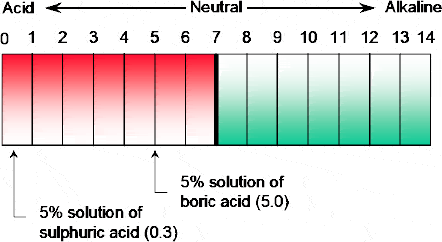
Redundant feeders operating in parallel
This scheme does not require any automatic transfer provision but care is required to ensure that both feeders do not trip in the event of a fault in one of the feeder lines. Note the current flow to a fault F in feeder 2. This fault is fed by both sources and can cause tripping of both supplies at the same time. To avoid this problem, specific protective devices must be provided and coordinated to ensure that only feeder 2 is isolated from sending and receiving ends. For example, such discrimination can be obtained by providing line differential protection for each feeder for selective tripping.
Another variant of hot standby source is that of a generating source operating in parallel with the main source. Figure 3.3 shows such an arrangement.

Redundant generator source operating in parallel with main source
In Figure 3.3, the utility source feeds part of the loads, with the local generator acting as hot standby source to critical loads. Both these sources operate in parallel. However, use of such a scheme requires caution. When the main source fails, the emergency source, which is operating in parallel, will take up not only critical loads, but the other non-critical loads also (see Figure 3.4).

Redundant generator source operating in parallel with main source – Mains failure mode
Obviously, the standby generator is unlikely to be rated for all these loads. Unless the load is quickly brought down to a value within the rating of the generator, the standby source will also trip. This redistribution of power is performed in two ways. One is to isolate the connection between the critical load bus and the rest of the system. In case the critical loads exceed the available generation, the relatively unimportant among them can be disconnected, though normally such a contingency should not arise. Figure 3.5 shows the status of the system after the above steps are taken.
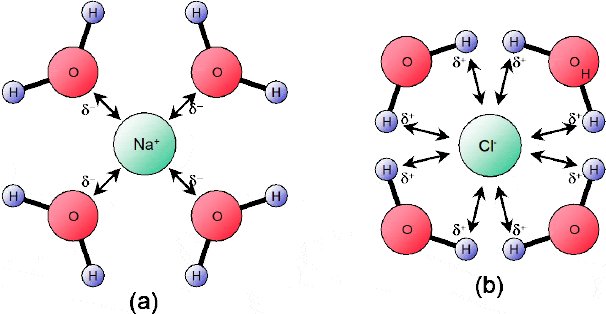
Redundant generator source operating in parallel with main source-Mains isolation mode
Usually this form of isolation is achieved by a combination of under-frequency relays, rate of change of frequency relays and reverse power relays, and is standard in all cogeneration-based systems.
No-break supplies such as UPS systems or DC power supply systems belong to the hot standby category. They operate in tandem with the normal source of supply and take over without a break when the mains supply fails. However, these sources are configured in such a way that the elaborate isolation measures discussed above are not applicable to them.
3.2 Multiple units nearer consumer vs larger centralized units
One of the solutions increasingly being adopted for emergency power supply is the installation of distributed generation capacity in the system. Utilities either own such capacities themselves or permit industrial consumers/other third parties to set up this capacity and operate them in tandem with the system. This has several advantages:
- They are usually close to the load and are not affected by transmission circuit problems
- They are usually capable of being started and brought up to load faster
- When owned by industrial consumers they also serve as standby sources
- When run as base-load generators synchronized with the utility system, they can serve as uninterrupted power source for the consumer
- They improve the voltage profile in remote end-of-line distribution circuits
- Often, cleaner energy technologies are used in these equipment (such as biomass power plants and fuel cell generation units)
Installation of multiple emergency power units has significant advantages in comparison with single centralized power supply configuration. Following are some of the benefits of multiple power supply operation:
3.2.1 Increased Reliability
Multi mode of operation has inherent redundancy and therefore offers significantly higher reliability to critical loads. In the event of failure of one of the generators, the load is shared by the other healthy generators without causing interruption to the load. In the case of a single generator unit, the breakdown of the single generator would result in a total loss of power supply to the load.
3.2.2 Flexibility
Multiple generator units offer the flexibility of locating the generators in various locations nearer to the loads. In addition, the smaller size of the individual generators makes it possible to install them in smaller locations with space constraints.
3.2.3 Expandability
Multiple generator operation facilitates the addition of new loads without the problems of either under utilization or the unavailability of power capacity of a single generator for some of the newly added loads. For increasing additional capacity, new generators can be installed in addition to the existing generators matching the requirement.
3.2.4 Serviceability
Multiple generator units have the advantage of ease of serviceability. Generators can be taken for maintenance without causing hindrance to the supply of power to the loads.
3.2.5 Cost effectiveness
The generators in a multi generator installation, due to their relatively smaller size and capacity are usually high volume equipment, and are more widely used than large capacity generators installed in single generator facilities. Large scale production of the generators, results in lower cost due to economies of scale than the low volume manufactured large capacity generators.
3.2.6 Transmission and distribution costs
The costs are expected to be marginally lower in the long term when compared with a centralized power supply system.
3.2.7 Environmental Impact
Impact is generally lower due to smaller size of the generators
3.2.8 Fuel economy
When the power demand is low, generators can be taken off line in a multi generator system, whereas in a single generator system, the generator has to be run at low load levels resulting in low fuel efficiency.
Multiple parallel generation units have the following drawbacks:
- Special panels and equipment are required for the paralleling and synchronizing of the generators
- More space is required for the installation of multiple generators
- More complex control and protection systems are required for a multiple generator set-up in comparison with a single generator unit
- Load sharing between the generators may not be uniform depending on the operation characteristics of the governors of the individual generators
3.3 Typical distribution scenarios in large industrial systems for integration of emergency power
The need for critical and emergency power in a large industrial system is complex and varied. While some loads can tolerate a brief period of power interruption and can therefore be catered for by standby DG sets, some other loads would demand an uninterrupted power supply which can be catered for by a battery based UPS system. It may so happen that one part of the industrial section may depend for its function on a not so critical equipment located in another section of the industrial complex. A transfer pump for transfer of a finished product like hydrocarbon, in one section, may not pose a problem in its area due to stoppage; however, it could result in a disruption of production operations in another section of the complex. Figure 3.6 shows a DG system in conjunction with a battery based UPS system for catering to critical loads that are interruption sensitive and that are not so sensitive to brief interruptions.

Typical Distribution scenario utilizing DG set and Battery based UPS
3.4 Capacity and voltage planning for emergency power in large industries
Once the decision has been firmed up to install emergency power systems in a distribution network, the next step is to assess the capacity requirements of the proposed emergency system. Following are the various factors that need to be considered when estimating the capacity of the emergency power system:
3.4.1 Capacity requirements (kW/kVA)
The sum total of power in a consolidated equipment list is the “connected load”. However, the actual power usage may be less because each unit may not draw the maximum connected load power continuously or simultaneously. Allowances should be made for future growth.
The internal impedances and momentary overload characteristics of any local power source/transformer, need assessment for adequacy to handle the short term demands without installing larger capacity than needed, for the steady-state load. Are the internal impedances low enough so that transient (or switching/starting) currents will not create excessive voltage disturbances?
The predicted line voltage sags, surges, and impulse transients should be checked. Note that ordinary switching of loads can be expected to create momentary impulse voltages as high as the peak value of the sine wave.
Circuit Breaker Sizing
Because the circuit breaker is a safety device, it should be sized carefully. Apart from carrying the normal load current, breakers have to interrupt fault currents quickly without themselves getting damaged in the process. The following factors should be taken into account when determining the sizing of the breaker:
- Continuous existing load current carrying capacity
- Margin for all known future loads (ex. 10%)
- Interrupting capacity for available fault current
Refer to Figure 3.7. The capacity of the main breaker should take into consideration the capacity of the future 600A breaker:

Consideration of future spare capacity in the sizing of breaker
Transformer Sizing
Transformer sizing should take into consideration the following factors:
- Total Connected load
- Total Demand load
- Total Diversity load
- Load Growth factor
- Projected Future load
Connected load is the total of the name plate power ratings of all the loads connected to the system. However, the actual power consumed by the loads may not be equal to the name plate rating of the loads. The actual power demanded by the loads may be less, and a factor called Demand factor is used to arrive at the Demand load from the Connected load. However at any point in time, all the loads may not be in operation and hence the actual power requirement may be lesser than the total demand load. The factor termed Diversity factor is used for arriving at the Total Diversity load from the Total Demand load. Taking into consideration growth in loads, a factor called Load Growth factor is used to arrive at the kVA rating of the transformer. Finally, consideration is given for projected future loads and an adjustment is made to arrive at the final kVA rating of the transformer.
Refer to the following calculation in deciding the rating of the transformer:
- Total Connected Load: 420kVA
- Load Demand Factor: 80%
- Diversity Factor: 0.95
- Load Growth Factor ( 10% )
- Projected Future load ( 20% )
Calculation
Total Connected Load: 420 kVA
Total Demand Load: 336 kVA (80% of 420 kVA)
Diversity Factor: 0.95
Diversity Load: 336 x 0.95 = 320 kVA
10% Load Growth Factor = 32 kVA
Total Load: 352 kVA
Total Load Capacity for which transformer is selected: 352 x 1.2 = 422 kVA *
* (20% projected future growth in loads)
3.4.2 Part Load Efficiency
The following aspects need to be checked:
- Has verification been made of the operating efficiency under part load operation?
- Has the estimated total load been compared with the expected steady-state actual running load of the system? Has this result been used in determining the “part load” ratio as a percentage of the name-plate kVA/kW of the power conditioning device? Many times, the equipment rarely runs higher than 50-60% of the name-plate capacity of the equipment.
In order to assure optimum efficiency, manufacturer’s guarantees should be obtained.
4
Special Requirements for Emergency Systems
4.1 Control room power and escape route lighting
Power for the control room for instrumentation DCS, PLCs, etc., is essentially provided from a UPS system, since interruption of power, even for a very short duration, can put the whole process control system in jeopardy. Availability of this uninterrupted power during a main power outage facilitates in either performing a controlled shut down, or alternatively, organizing and running the critical processes alone with the aid of emergency generators. Lighting for control rooms should be provided with 100% power and active operation areas provided to the extent of approximately 20% power from essential/standby power system. This power is required for attending to the issues arising out of the outage as well as for the safe access and egress of personnel.
4.2 Automation of starting, load changeover and shutdown
In a manually operated emergency power system, in the event of a utility power failure, the diesel engines have to be started manually, brought up to speed, loaded with the critical loads, synchronized one by one, and additional loads added. In the event of a failure of one of the generators, some have to shutdown taking care not to interrupt the power to the critical loads. All these activities take time to execute, the actual time duration dependant upon the availability and skill of the personnel. Power to the critical process loads is interrupted during this transfer time. Disruption to process due to the extended power interruption results in quality deterioration, loss of production, added efforts to bring the process back to stream, requirement of man power, loss of revenue etc. Hence the need for an automated emergency system. In an automated system, the engines are automatically started, paralleled and the emergency loads transferred to the generators without manual intervention during a utility power failure.
In the automatic system, when ‘automatic operation’ is selected, the emergency generators are kept in a standby mode. When the system issues a start command to the engines, all the engines start and the first engine to reach speed and voltage is connected to the emergency bus and the emergency loads are then automatically transferred to the emergency bus. The remaining generators are then automatically synchronized to the emergency bus as and when each generator attains the voltage and speed. With the addition of generation capacity, more loads are automatically transferred to the emergency bus. The system has an alarm system to automatically shut down an engine generator if so required. The system is also endowed with a load shedding feature by which non-essential loads are automatically shed in the event of failure of a diesel generator. Continuity of power supply to the critical loads is thereby assured.
Figure 4.1 illustrates the schematic of an automatic emergency and paralleling system. Both the ATS are closed in the position shown during normal times, supplying power for critical and non-critical loads from utility source. In the event of a power failure, the automatic emergency system opens the breakers connecting the utility source and switches the ATS of the critical load to the generator bus. At the same time, the generators are started and synchronized with the emergency bus one by one. The breaker supplying power to the critical load is closed, providing generator power to the critical loads. When adequate generation capacity is reached, the breaker for the non-critical loads is also closed, providing power for non-critical loads.
When the utility power supply resumes, an automatic transfer switch system transfers the loads back to utility supply. When all the loads have been safely transferred, the breakers of the generators are automatically opened and the generators shut down after a cool down run through time duration. The generators are then ready again in a standby mode. As can be seen, the automatic system is inherently faster, safer and more efficient than a manual system.
Encorp makes APS (Automatic paralleling switch) for single generator and multi generator automatic paralleling switches. ‘Detroit Diesel’ make SD series paralleling switchgear in a multigenerator automatic generator management system.

Automatic Emergency Generator System
4.3 UPS and other power conditioning requirements
For loads requiring uninterrupted power, the following aspects must be verified:
What level of power continuity will satisfy sensitive operating requirements? Without supplementary energy storage devices, many units will ride-through a 5 to 20 ms interruption of power without malfunction, provided noise impulses associated with the interruption do not reach and corrupt digital signals by other paths.
Motor generators can extend ride-through to as long as 20 seconds. The frequency tolerances of the specific loads must be ascertained. UPS can extend ride-through interruptions typically 5 to 30 minutes or longer. UPS installation with emergency standby diesel power can extend ride-through almost indefinitely.
Does the power conditioner or independent power source have adequate capacity for its limits on load current, kVA and kW output? This will vary with the power factor of the load. Some devices such as static UPS have very little overload capability and depend upon a stiff, low impedance bypass power source (usually the public utility) to supply large starting loads. Verify that the power source and any bypass will supply all in-rush needs and still provide the power quality which is needed.
If voltage regulators are used, verify that their response times are fast enough to follow line voltage changes, yet will not interact with regulators in the sensitive loads. Determine if a step-by-step approach to power conditioning will be possible. For optimum lowest investment consider first a power conditioner with “conversion” capability to battery support in the field at some later date, without loss of initial investment.
The voltage for the emergency system basically depends on the requirement of power by the emergency loads. The greater the power requirement, the higher the system voltage in order to reduce the size of the power generation and transmission equipment.
4.4 Paying attention to motor starting requirements and accompanying voltage sag
A voltage sag is defined as a decrease in rms voltage magnitude between 10% and 90% at the power frequency for durations from 0.5 cycles to 1 minute, reported at the remaining voltage. Figure 4.2 shows the voltage sag wave form of a power supply:

Voltage Sag
Voltage sags are usually caused by faults in the system: however they are also caused by the switching of heavy loads or the starting of large motors. An induction motor typically draws six to ten times its full load current during direct on line starting. Such a high current results in a voltage drop across the cable or feeder impedance of the system. Figure 4.3 shows the phenomenon of voltage drop during the startup of a large motor:

Voltage Sag due to startup of a large induction motor
Figure 4.4 shows the voltage wave form at the terminals of a large motor during startup. The voltage at the terminal of the motor is seen to drop up to 80% and take 4 seconds to regain the normal voltage level in this case:

Voltage Sag wave form at the motor terminal during startup
4.4.1 Effects of Sags
A fall of voltage affects different equipment in different ways with the severity depending on the sag magnitude. In the case of loads consisting of passive elements (pure impedances), the output power (both active power and apparent power) gets reduced corresponding to the square of voltage. For example, in a lamp load (a pure resistance R), the power output is given by the equation:
Power = V2/R
An incandescent lamp will thus have a lower output at lower voltage. The actual brightness falls steeply and is governed by the light emission characteristic of the filament at different temperatures. A special instance of this type of problem is called ‘flicker’ which happens due to rapid and repeated voltage sag (several times a minute) causing corresponding changes of lamp brightness. Flicker is very annoying to users and needs to be controlled. Typical causes of flicker are loads such as welding and arc furnaces.
Discharge lamps are generally not affected by voltage dips and their light output remains constant over a large range of low voltage. However, lamps nearing the end of their service life tend to extinguish even at fairly small voltage dips. For restart, a hot lamp requires higher striking voltage and therefore, restoration is rather slow even after the voltage has come back to normal, unlike incandescent lamps, where there is no such delay.
Of major concern in an industry is the behavior of motor loads. Motor torque falls because of lower magnetic flux generated. In order to support the load, an induction motor tends to draw a higher current so that there is equilibrium between the load torque and motor torque. Synchronous motors tend to compensate by an increase of the mechanical load angle between the stator flux vector and the rotor flux vector. In both cases, self-correction is possible only up to a point. Voltage falling beyond a critical point will cause the motor to pull out of step and trip. Sags occurring for short periods are however less serious compared to those lasting for longer periods of more than a few cycles. This is because of the mechanical inertia present in the system, which compensates for the fall in motor torque. A transient stability analysis is however necessary, particularly for large machines, to ensure that the critical limits of operation are not exceeded.
Another aspect of sag, which is specific to LV systems, is the behavior of relays and contactors. Large sags invariably cause the contactor’s controlling motors to drop out. The point of the waveform where the dip occurs is also important and the danger of dropping out is less if the dip occurs at the peak value of the voltage waveform. Even though the motor itself may be capable of riding through a sag situation, its starter may cut the power off and cause the motor to stop. High voltage drives which are switched using latched contactors or circuit breakers are not generally affected in this manner. Very often, a small motor serving a critical requirement such as lubrication for a much larger system, trips and causes the system served by it (say a large compressor) to also trip resulting in severe adverse consequences.
In order to mitigate the effect of sag arising from huge motor startups, the following options can be adopted:
- Supplying large motors through a supply separate from the one that is supplying the sensitive loads
- Starting the motors using a starter mechanism, such as star-delta starter, auto transformer starter, resistance starter, soft starter etc. However, the load connected to the motor should permit the use of such reduced voltage starting since there would be a reduction in the starting torque developed by the motor with reduced voltage start method
A vast number of large equipment such as AC and DC variable speed drives are provided with low voltage protections to shut down the drive under severe sag conditions.
4.5 Safe shutdown requirements
The abrupt disruption of power to critical process can result in serious safety hazards to personnel and major damage to equipment. For example, the failure of a cooling system due to power outage can result in a process going into a runaway reaction mode causing grave consequences to personnel as well as equipment. The abrupt failure of an agitator to stir the contents of a chemical mix can cause solidification of the contents resulting in a long downtime and costly breakdown of the equipment. Emergency power system is advocated in such kind of areas for providing power to the equipment during a utility power outage, until the process is brought safely to a controlled halt. The emergency power should be adequate both in terms of capacity and availability duration for the safe shutdown of the process. Emergency power may be used only for the safe shutdown of the process and not for its continued operation owing to reasons of practical limitations in putting up a huge power plant for running the total process.
5
Harmonics in Emergency Supply Systems
5.1 Harmonic producing loads and their effect on generator capacity
All theoretical discussions of AC power systems and equipment working on these systems assume that the AC voltage and current waveforms are true sinusoids and have a perfect sine wave shape. This is no longer true in the practical power networks of today where the currents and voltages are distorted in complex ways, though they still conform to the periodicity of the system frequency. The term HARMONICS refers to this distortion. Following are the common factors:
Current waveforms show some degree of distortion:
- They have a definite periodicity which corresponds to that of the supply voltage
- They may are may not be symmetrical (identical in positive and negative half cycles)
Any waveform that is non-linear in nature but has a definite periodicity can be said to contain harmonics. While transient events such as surges, sags and swells last for a definite time, from a few milliseconds to several cycles and cause changes to the amplitude or waveform, distortions introduced by non-linear loads are continuous. Harmonic distortion is one of the major power quality issues in modern power systems.
Harmonics consists of several even and odd frequency sinusoidal waveforms of multiples like 2f, 3f, 4f, etc. of the fundamental frequency ‘f’. Of these harmonics, the third harmonic, is the most frequently encountered harmonic created by transformer and generator star connected neutrals. The third harmonic current has a frequency of three times the fundamental frequency with a magnitude of one third the fundamental. Figure 5.1 shows the third harmonic current wave form and the resultant distortion in the original waveform. If two or more neutral points of the star connected windings of transformer or generator are grounded or connected mechanically by neutral wire, 3rd harmonic currents flow through the neutral wire as shown in Figure 5.1. The triple harmonic components of the currents flow through all the three phases of the star connected system and the lines via the earth return path. Harmonics produce additional hysteresis loss, eddy current loss, negative sequence torque, reduced efficiency, rotor heating etc.
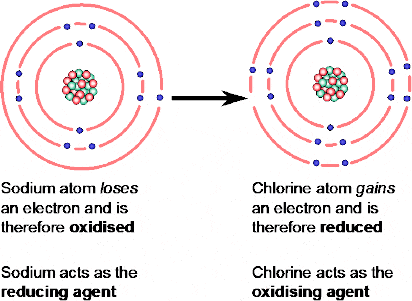
3rd Harmonic Current
The problems related to harmonics can either be due to the harmonic current flow or due to the presence of harmonic voltages in the system. The following are the types of problems that harmonics can cause in a power system:
Problems caused by harmonic currents:
- Overloading of neutrals
- Overheating of transformers
- Spurious tripping of circuit breakers
- Failure of power factor correction capacitors
- Skin effect
- Electromagnetic interference
Problems caused by harmonic voltages:
- Voltage distortion
- Operation of motors
- Zero-crossing noise
Loads that produce harmonics are of particular concern in applications where emergency generators are used to maintain services during utility power outages.
Harmonics result in the following problems in a generator:
- Increase in current flow through the neutral. For a balanced three phase load application, the current in the neutral is negligible. However, harmonics result in substantial current to flow through the neutral of the system. Hence the sizing of the neutral conductor has to be increased to accommodate the harmonic currents
- Emergency generators have three or more times the impedance possessed by utility sources. Thus, for the same harmonic current drawn by the load, the harmonic voltage is three or more times larger in an emergency generator
- Harmonics cause the voltage waveform to get distorted, resulting in interference to the functioning of the generator’s voltage regulator
- Harmonics cause additional heat to be produced in the generator due to increased eddy current losses and due to creation of magnetic fields at harmonic frequencies. The generator has to be derated suitably in view of this additional heating effect produced by harmonics
The magnitude of harmonics is stipulated in terms of ‘Total Harmonic Distortion’ (THD), factor which is the ratio of all the harmonics to the root mean square value of the fundamental. THD is usually expressed as a percentage. The THD produced by the UPS should be within the stipulated limits. The input current total harmonic distortion (THD) shall be tested under rated linear load conditions with the AC input source specified by the UPS manufacturer and the input source voltage shall be set to the nominal value. The THD of output voltage is stipulated separately for linear loads and switch mode type loads. For example, the THD of output voltage can be stipulated to be less than 5% RMS for a 100% linear load or less than 7.5% for a 100% switch mode type load.
5.2 Tackling harmonics produced by static UPS
Harmonics can be injected into a power system by an UPS, both at the input and at the output. A static UPS system typically contains the basic building blocks of a rectifier input section, a battery storage centre section and an inverter output section. Rectifiers create a non-linear voltage-current behavior, causing harmonics to be injected into the power system. Similarly if the output voltage of the UPS does not have a perfect sinusoidal wave form, harmonics would be produced at the output of the UPS also. It is desirable to limit the current harmonics to about 8% maximum total harmonic distortion (THD) at normal conditions and at full load conditions, and limit the rectifier/charger output ripple RMS voltage to less than 2% of the nominal DC voltage with batteries disconnected. Curtailment of harmonics thus produced, needs special design features such as the following:
- Installation of filters
- Using higher pulse (12 pulse or more) rectifier than the simple 6 pulse rectifier
Installation of harmonic suppression filters at the input and output of the UPS suppresses harmonics to desirable limits. Figure 5.2 shows a block diagram depicting harmonic suppression filters installed at the input and output of the UPS:
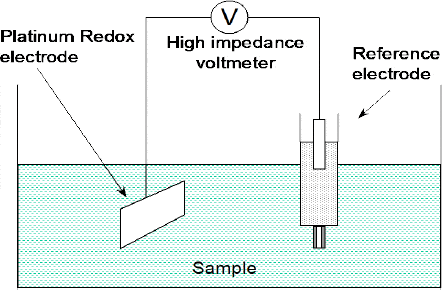
Input and Output Harmonic filters
Figure 5.3 shows a six pulse rectifier at the input stage of a three phase UPS:

Six Pulse Rectifier
In large ratings, it is usual to employ two such rectifiers in parallel effectively forming two six-pulse bridges, fed from a star and a delta transformer winding, thus providing a 30 degrees phase shift between them. This is demonstrated in Figure 5.4:

Twelve Pulse Rectifier
6
Parallel Operation of Emergency Sources
6.1 Parallel operation between emergency sources
A multiple source emergency power system comprises of two or more generators supplying power to a common electric network as in the case of a site power plant having multiple generators in an industrial complex. Two or more generators are normally operated in parallel in order to increase the available power. The generators in a multi source system run in synchronism with each other and the performance of every generator affects the performance of the other generator. The vector difference between the voltages generated by the generators results in a synchronizing current flow between the generators which keeps the generators locked in synchronism. The power flow patterns and transient behavior of a multiple source network are more complex than that of a single source system. The total active power generated by all the generators equals the total active power consumed by the loads and the power shared by each generator is controlled by its governor setting. The generator with the higher governor setting shares more load than the one with a lower governor setting. The reactive power of the loads is shared by the connected generators in accordance with their excitation levels and rated MVA. Figure 6.1 shows a network comprising three generators interconnected and supplying power to the common network.
For paralleling of generators several factors have to be satisfied. They are:
- Phase sequence of the generators should be equal
- Generated voltage magnitudes should be equal
- Frequency of the generators should be equal
In addition to the above conditions, at the time of synchronization, the voltages of the running generator and the incoming generator should be in phase. Connection of the incoming generator with the already running generator when they are out of synchronization may result in severe damage to equipment and safety hazard to personnel. Synchronization can be achieved either by automatic means or manually, by using synchroscope or dark lamp method.
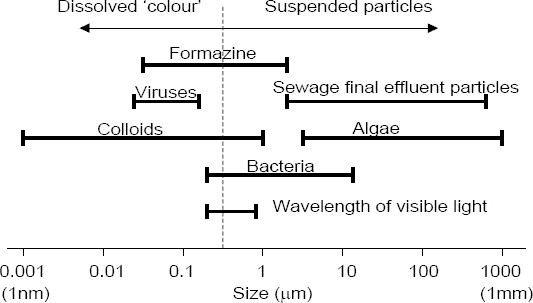
Multiple Generator Emergency Power System
6.1.1 Synchronizing: lamp method
Varied schemes which use lamps for synchronization are available. One such scheme is shown in Figure 6.2. The scheme uses three pairs of lamps connected as shown and is called the ‘Two bright lamps and one dark lamp’ scheme. G1 is the running generator and G2 is the incoming generator. When the running generator and the incoming generator are not in synchronization, all three pairs of lamps glow and flicker. When the lamp pairs in phases B and C are in the midst of the bright period and the lamp pair in phase A is dark, the two generators are in synchronization and the breaker between them can be closed. Both generators then get locked in synchronization and operate in unison with the same frequency. Figure 6.3 shows the voltage wave forms (of one phase) of the two generators during synchronization process. Due to the small difference in frequencies, the waveforms merge and separate as shown in the figure:
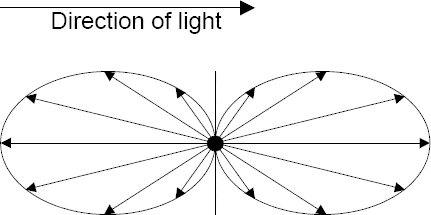
Synchronization using dark lamp method
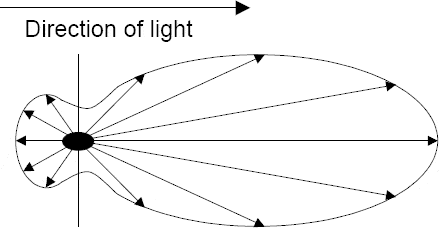
Voltages of generators while synchronizing
6.1.2 Synchronizing: synchroscope method
Synchroscope is basically a power factor meter connection to measure the phase relationship between the generator and bus-bar voltages. The moving element is free to rotate continuously. When the two frequencies are exactly the same, the moving element holds a fixed position. This shows the constant phase relationship between the generator and bus-bar voltages. When the frequency is slightly different, the phase relationship is always changing. When this happens, the moving element of the synchroscope rotates constantly. The speed of rotation is equal to the difference in frequency; the direction shows whether the generator is fast or slow. The generator is placed on line when the pointer slowly approaches a mark. This mark shows that the generator and bus-bar voltages are in phase:
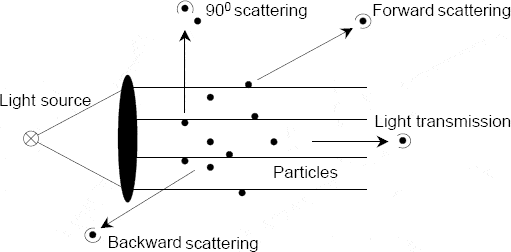
Operating principle of Synchroscope
Synchrocheck Relay is also used, which compares the phase angle, frequency and/or voltage of the generated power with that of the bus. It permits paralleling when the parameters of the generated power and the bus power are within tolerance.
6.2 Load sharing between Sources
Load sharing in an installation containing two or more generators and can be achieved either by ‘Isochronous load sharing’ or ‘Droop load sharing’.
6.2.1 Isochronous load sharing
Isochronous operation refers to the operation mode of parallel connected generators in which frequency of the generated voltage is independent of the load. In Isochronous load sharing, two or more governed systems loaded in parallel, share the load proportionally while operating isochronously. Isochronous operation is achieved by monitoring the power output of the generator and modulating the fuel to the engine so as to produce equal or proportionate load sharing with respect to one or more other generator sets, connected to the same electrical power bus. A load sensor is used with a basic electrohydraulic or electronic speed governor to accomplish isochronous load sharing.
6.2.2 Droop load sharing
When two or more generators connected to a common electrical bus are operated in parallel, a methodology called ‘droop load sharing’ is used for the sharing of the load between the generators. For example, in a diesel engine generator set, the engine of the generator set is provided with a droop setting by which the speed of the engine reduces along a predetermined slope with increase in load. When the load on a particular generator gets increased because of some reason, the speed of the generator reduces on account of the droop setting, causing the load to get transferred to the other generators. Droop is expressed as the percentage change in speed corresponding to the change from zero to full power output. Figure 3.5 shows the droop characteristics of a generator.

Droop characteristic of Generator
The power output of each generator is determined by the bus frequency, the respective engine speed setting and the droop setting. To obtain proportional load sharing, the droop or regulation of each generator set should be identical to the others. Generally a droop of 5% is provided for the governor of the engine to enhance system stability. Droop load sharing system can be expected to provide proportionate load sharing within 20% of the respective power rating of the engine. For multiple generator set installations, where speed regulation need not be better than 3 to 5%, droop load sharing system may be used.
6.3 Parallel operation of emergency source with utility (normal) source
In order to provide uninterruptible power supply to critical loads, emergency sources such as diesel generator sets are often operated in parallel with the Utility source (normal source). Such a scheme is shown in the figure 6.6 where the diesel generator is synchronized with the grid power supply. In order to operate such a scheme, permission has to be obtained from the Utility in addition to providing necessary synchronizing and protective relay devices such as reverse power relay, vector surge relay etc. for generator protection. Depending on whether the plant load is more or less than the power generated by the generator, power is either drawn from the Utility (imported power) or is delivered to the Utility (exported power) respectively. In the event of a disturbance or failure in the utility power source, the incoming breaker can be opened to isolate the site generator from the utility network and continue power supply to site loads using the generator. Similarly in the event of a problem in the site generator, power can be availed from the utility. Hence the reliability of power supply to the load is enhanced by the generator-utility paralleling scheme.

Parallel operation of Emergency source with Utility
6.4 Pros and Cons of Parallel Operation
The significant and important advantage of operating a site generator in parallel with the utility power network is the improved reliability of power supply to the critical loads. Failure of power in either of the sources is compensated and taken care of by the healthy source, and power supply to the critical loads is maintained. Another advantage is that, in the event of a surplus power generation by the site generator (e.g. due to shut down of loads for maintenance etc.), the surplus power can be exported to the utility. On the negative side of this scheme, any disturbances occurring in the utility power grid, impact on the power supply to the site loads. When there is a serious disturbance or power failure in the grid, the local generator sets have to be immediately isolated from the power grid in order to protect the critical loads. In the event of a reclosing in the utility network after a momentary power interruption, if the site generator had not been isolated quickly, there is a serious danger of the utility power clashing with the generator power asynchronously causing major damage to equipment. Reliable and fast acting protection relays are a must in protecting the site generators from such an eventuality. In the event of the local generators not being able to meet the full requirements of the site load after islanding, load shedding scheme should be installed, so that non-critical loads would be immediately shed from the generator supply. Failure of fast load shedding would result in the site generators going out of step due to excess loading causing them to trip also.
6.5 Automation for paralleling – available equipment
Paralleling of generators manually is a skilled job requiring experienced operators and takes several minutes to complete even under favorable conditions. The generators have to be started, brought up to speed, voltage raised to the required level and speed adjusted for synchronization, all of which take time. When system conditions are not stable, the job becomes all the more difficult and tricky. On the other hand, digital automatic paralleling systems have the major advantages of reliability, flexibility, simplicity, ease of operation, compact size and fast operation. Synchronization can be done in less than 15 seconds using the digital paralleling system. The system also facilitates diagnosis, data monitoring, and control functions such as governing, synchronizing and voltage regulation using a modem and PC. Modular design concept used by this paralleling system enables minimizing of engineering time during planning and designing the power system. The digital system also provides for metering, remote monitoring, graphic and audible indication of alarms, trips, warnings, event logging, engine status parameter monitoring and time/date stamping.
Figure 6.7 shows the schematic of a digital paralleling system. The automatic system parallels the generator to the emergency bus automatically by controlling the voltage and speed of each generator. Once the voltage speed of the incoming generator is matched with the running generator and both are in phase, the breaker of the incoming generator is closed connecting it to the emergency bus. The switches shown enable connection of the loads either to the generators or to the utility power supply.
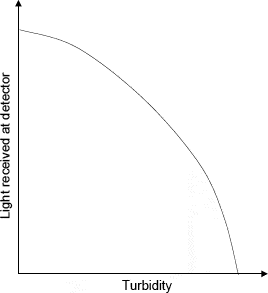
Automatic Digital Paralleling System
6.6 Utility stipulations and local codes
Design of power generation installations intended for connection to utility grid should be performed by personnel with engineering competence and thorough knowledge of the effect of linked generation sources in conjunction with the operation of the utility grid. The following factors should be considered in the designing of such generator installations:
- Safety of personnel
- Voltage control
- Import/ Export limits for power
- Synchronizing and islanding provisions and methods
- Metering systems
- Fault levels
Approval should be obtained from the utility for the linking of the generators with the utility grid. The generator owner’s distribution system should further comply with the statutory and regulatory requirements including:
- The Wiring Rules
- Standards, Regulations and statutory requirements pertaining to generating set installations
- Customer connection contract
- Operation during agreed time periods with agreed stipulations on import/ export of power
- Ensuring that the reliability, integrity and safe operation of the network are not compromised
- All protection equipment shall comply with prescribed standards. The protection settings and schemes shall comply and be approved by the utility and shall have satisfactory coordination with the utility’s protection equipment
Generators should have islanding protection. Generators shall be automatically and immediately disconnected from the utility network on the following occasions:
- Loss of supply from the Utility
- Exceeding of agreed limits of real or reactive power
- Generator going out of step
Generator owner shall monitor the installation to adequately safeguard the utility personnel, public and to protect the network. Generator owner shall comply with the quality requirements of power generated by the generators. The utility may disconnect the generator installation from the network if:
- The equipment is unsafe to personnel
- Connection with the generator system is detrimental to the integrity of the utility grid
7
Tie Protection Systems
7.1 Avoiding emergency generator collapse on external events
Operation of an emergency generator in parallel with the Utility needs careful attention to the provision of devices to prevent collapse of the generator on account of disturbances in the grid. Some of the disturbances of the grid are as follows:
- Under voltage (due to occurrence of fault)
- Over voltage (due to sudden removal of huge load)
- Under frequency (due to overloading of system)
- Over frequency (due to sudden removal of huge load)
- Grid power failure (due to failure of generating station)
- Fault in grid
In the event of Utility power failure (e.g. due to some fault), a large external load will be suddenly thrust on the site generator, which it may not be capable of taking up. In such cases, if the generator is not isolated from the Utility fast enough, it may lead to the tripping of the site generator and a total power failure for all the critical loads supplied by the generator. In the event of a continuous running of the generator without tripping in the above case, if the Utility power is again resumed by an auto-recloser, the Utility power will be imposed on the generator without synchronization, leading to catastrophic damages to the generator and associated equipment.
In order to protect the generator from collapse due to grid problems, the generator needs to be isolated quickly from the grid through reliable and fast sensing protection devices. A sudden drop in system frequency (rate of change in frequency) can be detected by means of a electronic relay, and failure of the Utility power can be detected by means of a vector surge relay. Disturbances due to faults in the grid can be detected by means of over-current cum directional earth fault relays.
7.2 Appropriate protection: reverse power, frequency rate and vector surge relays
7.2.1 Reverse Power Relays
Under normal healthy conditions, a generator in a multi generator system supplies power to the common bus. In the event of a problem in the engine of such a generator, the power output of the generator may get reduced resulting in the reverse flow of power from the bus back to the generator. This will lead to motoring of the generator causing damage to the engine and the generator. A reverse power relay is used for the detection of such reverse power flow into the generator and protection of the generator through tripping.
7.2.2 Frequency Rate Relays
Frequency rate relays, also known as df/dt relays, are used for the detection of the rate of change of frequency in a power system and have the following applications:
Load shedding schemes: Sudden overloading of a power system may occur due to reasons such as the tripping of line, generator etc. Such sudden overloads cause the running generators to lose synchronism and get tripped. Overloading of a power system causes a drop in frequency. The fast drop in frequency due to sudden overloading is detected by the df/dt relay, which issues a signal to trip non-essential loads thereby protecting the running generators.
In a system where the site generator is connected to the utility grid, df/dt relay is used in conjunction with a vector surge relay to isolate the site generators from the utility when a fast frequency drop is detected in the utility grid.
7.2.3 Vector Surge Relays
Vector Surge supervision relays are used for the protection of synchronous generators connected in parallel with the Utility. In the event of utility power failure, these generators need to be decoupled very quickly from the Utility. This is due to the fact that, in the event of auto reclosing of the Utility power, while the generator is still connected to the Utility, asynchronous linking of power may result between the Utility and the generator causing major damage to the generator. Also, in the case of a long lasting Utility outage, the generator would start feeding power to the Utility, which is well beyond its capability, causing it to trip.
Vector Surge supervision relay, measures the time duration of each voltage cycle starting from the zero crossing point of the voltage waveform. This measured duration is compared with a reference value. During a vector surge, condition caused by utility outage, the actual cycle duration, becomes either more or less than the normal duration. This variation is detected by the relay. Refer to the voltage waveform in Figure 7.1, which illustrates a shift in the waveform during a vector surge. The angle displacement setting is selectable in the surge protection relay. However, vector surge relay can detect a surge condition when the load is minimum in the range of 15% to 20% of the rated load. Once the relay detects the abnormal condition, it gives a trip command to isolate the generator from the Utility. The surge relay detects a Utility failure in about 60ms and total isolating time of the generator from Utility is less than 150ms:
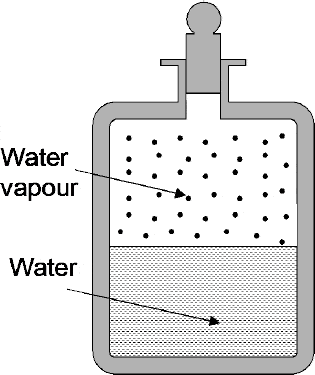
Vector Surge phenomena
Vector surge supervision protection can be applied for two types of systems:
- Only parallel operation of generator with Utility without island operation: In this case, the protection relay trips the breaker of the generator in the event of Utility failure. No power is supplied by the generator to the loads
- Parallel operation and island operation: In this system, the surge relay trips the main breaker connecting the generator and utility, permitting the generator to supply power to the site critical loads
The following two cases should be considered during designing the vector surge protection scheme:
- The vector surge relay acts only when it sees a change in power to the tune of 15% to 20% of the rated power. So, in the event of Utility power failure which does not result in such magnitude of power change, the vector surge relay may fail to detect the Utility failure and remain inactive. Such an event can happen when the Utility gets isolated near the generators causing them not to experience any additional load. On the other hand, if the Utility power gets isolated at a far off place, the loads of the other customers in the vicinity of the generator cause a sudden loading of the generator, enabling the vector surge relay to sense the abnormality and act
- If the short circuit protection relays of the generator are provided with very low trip times, a possibility may arise, that these relays may trip the generator on seeing a short circuit in the Utility circuit, before the relays in the Utility circuit itself can react. To avoid this eventuality, the short circuit protection relays of the generator should be suitably time delay configured
7.3 Islanding of systems and generator behavior
Quite often, generators of industrial plants are operated in parallel with the Utility grid in order to have flexibility and reliability. The site generators in such cases operate in synchronism (having same frequency and phase) with that of the grid. In the event of disturbance in the grid, the generators which are connected to the grid are designed to be disconnected from the grid and operate independently to continue supply of power to the onsite loads. Such isolating operation of the generators from the utility grid is termed Islanding operation. Unintentional islanding of the generator can result in safety hazards, cause damage to equipment, deteriorate the quality of power and reduce reliability.
Two kinds of situations can be considered in parallel operation of the generators with the utility grid:
- Site generator supplying part load and balance being supplied from utility grid. In such a case, failure of the grid will result in the total local plant load shifting to the generator, which may lead to its collapse and a total power failure. To protect the generator from such an eventuality, load shedding scheme should be implemented that will trip and isolate all, but the critical loads, from the generator
- Site generator generates more power than local demand and is exporting excess power to the Utility. In such a case, in the event of sudden isolation of the generator from the Utility (tripping of breaker connecting generator and Utility) will result in an overshoot in the generator causing it to trip
Unplanned generator islanding can damage onsite equipment through supply of voltage and frequency outside the stipulated limits. In order to mitigate such potential problems of the generators, the generator protection schemes should be coordinated with the Utility protection scheme.
7.4 Load management in islanded systems
In an islanded situation, the generated power of the islanded generators should be more than the power demand of the connected loads to prevent the collapse of the generators due to overloading. An unbalance in the demand vs supply can occur due to the following causes:
- Sudden islanding of the generator due to a grid disturbance and consequent unavailability of generator power to supply all the connected loads
- Problem in one of the generators resulting in its tripping or inability to supply required power
- Sudden starting of some heavy load, like the starting of a heavy motor
In order to protect the critical loads from a total collapse of the site generators due to above conditions, it is required to have an automatic load shedding system. Automatic relays which sense an ‘under frequency’ and ‘rate of frequency change’ condition, immediately trip non critical loads from the generator connection and protect the system from getting overloaded.
At the same time, it should be ensured, that only adequate numbers of generators are run to avoid operating the generators at under-load conditions. Continuous operation of engines well below their rated capacities, apart from being uneconomical, would also result in the deterioration of the engines.
8
Emergency Power Equipment Installation
8.1 Ensuring availability of critical power supplies through proper installation
The proper planning, designing and installation of an emergency power supply system play vital roles in the reliable and satisfactory performance of the emergency system. All pertinent factors need thorough scrutiny right from initial stage, since errors and omissions of important details will not only compromise the performance of the emergency system, but will also prove expensive to rectify at a later date. An under performing emergency system can lead to costly power outages during a utility power failure. The following points should be considered and reviewed during the planning and designing of an emergency power supply system:
- A comprehensive list of all the critical loads which need to be provided with emergency power should be drawn up to prevent inadvertent missing of certain critical loads that can undermine the effectiveness of the emergency system
- Out of the list so prepared, assessment should be made as to which loads can be supplied using standby generators (loads that can tolerate brief power interruption) and loads which need to be supplied from UPS system (loads that cannot tolerate even a momentary power interruption)
- The capacity requirements for each of the above power supplies should then be ascertained taking into consideration:
- Adequate capacity margins in view of revisions in load ratings, inclusion of additional loads, shifting of loads between UPS and generator etc. Spare capacity margins should also be kept for load enhancements at a future date
- The battery capacity in UPS systems and the fuel storage capacity in a diesel generator system should take into account the duration for which emergency power needs to be supplied
- Spare generator installation is preferred in a multi diesel generator system, so that servicing is facilitated while ensuring availability of emergency power
- Redundancy in the form of parallel UPS systems and bypass features should be considered in a battery UPS system, to ensure emergency power availability in the event of a problem in the operating UPS or while performing maintenance on the UPS
- Selection of vendors both for the equipment and for the installation should be undertaken carefully, taking into consideration the reliability, workmanship, reputation, experience, after sales service, availability of spares, etc.
- The technology and equipment design should be of the latest type and should possess a record of proven performance in the field
- The workmanship during installation of the equipment is as important as the selection of reliable equipment. Improper installation and mistakes committed during installation may deteriorate the performance, compromise safety and reduce the life of the emergency power equipment
8.1.1 Selection of installation location
Adequate care is necessary while selecting the location for installation of the emergency source. The checklist below provides a review of some important factors:
- What kinds of hazards exist in the proposed location? Natural hazards – storm damage from wind, rain, snow, sleet, ice, lightning, flooding, tidal waves, fire, earthquakes, slides?
- Man made hazards – vandalism, sabotage, malicious mischief, arson, collisions from vehicles, riots
- Off-site damage to power and communications lines upon which supporting services depend
- Lightning and excavation damage, even in underground protected services. If there is more than one power feeder and more than one communication cable to the building, each should be placed in a separate trench rather than in the same trench
- Can separate distribution lines be fed from separate substations in the event one circuit is accidentally disabled or taken out of service for maintenance?
- Comparing electricity costs at different locations. Is the cost of electricity excessively high at the proposed location? What are the demand charge penalties and the lower power factor penalties? What effect will system efficiency have on actual operating cost?
- Are those responsible for commercial and for electrical wiring and apparatus installation reasonably responsive to the sensitive equipment’s needs? Are they adequately trained and do they have the necessary technical understanding to work co-operatively with users to help them solve power related problems?
8.2 Equipment cooling, premises ventilation and noise control measures
8.2.1 Cooling System
The engine of the emergency diesel generator in most of the cases is provided with a water cooling system comprising of:
- Direct driven water pump in the engine
- Remote radiator or cooling tower
- Engine shaft driven or motor driven cooling fans with thermostat control
- Water piping
- Cooling water failure alarm and trip protections: ‘Low flow’ and ‘High temperature’
The cooling system should have an adequate cooling capacity to ensure proper continuous operation at 100% rated load at the specified ambient temperature. A thermostat is provided for radiator bypass in cold climatic conditions, to control the cooling water circulation. Soft water should always be used for cooling to prevent sedimentation and corrosion in the internals of the engine.
Figure 8.1 depicts a schematic of a typical diesel generator system, showing the cooling system for the engine of the diesel generator.
Coolant for the engine is circulated by means of a coolant pump. The hot coolant from the engine is taken to a bypass valve, which, depending on the temperature of the coolant, diverts the coolant either to the heat exchanger or to the exchanger bypass line. If the coolant is hot, it is diverted to the heat exchanger and if the coolant temperature is sufficiently low, it is sent to the exchanger bypass line. After cooling, the coolant passes through the lube oil cooler, where it cools the lube oil. The coolant then goes to the coolant pump. Excess coolant from the heat exchanger is sent to the coolant tank.

Fuel, Air, Lubrication and Cooling System for Emergency diesel generator
8.2.2 Ventilation
Diesel generators that are installed indoors, require adequate ventilation for combustion and heat dissipation. Ventilation is provided by means of an adequate capacity air inlet, air outlet, exhaust fans and ventilation openings. The air inlet size should ensure that at least the minimum quantity of air flow, as specified by the manufacturer, is achieved. The following points should be considered in the providing of ventilation:
- Air inlet should be located well away from the air outlet, so that the exhaust air is not again drawn into the inlet
- Adequate capacity exhaust fans should be provided in the generator room to expel the heat from the generator house
- Adequate margins should be provided in sizing the air inlet louvers, screens etc to ensure adequate air flow, taking into account the restriction created by these to the passage of air
- The orientation of the engine should be aligned with respect to locations of the air inlet and air outlet so that the flow of air results in the proper cooling of the engine
- In the event of using ducts for air ventilation, as minimum a number of bends as possible should only be provided to reduce restrictions for air flow
- Air outlets should not be installed adjacent to walls or buildings to prevent amplification of noise levels
Figure 8.2 shows a typical layout of ventilation arrangement for an indoor emergency diesel generator unit. The flow path of air is such that it cools the generator and engine, and the exhaust is kept well away from the air inlet:
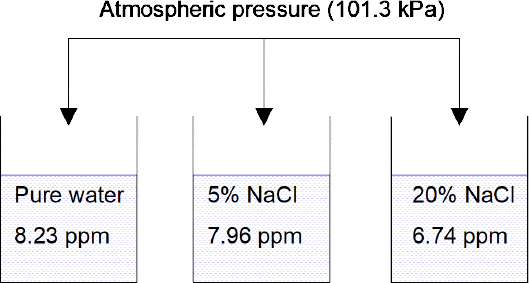
Typical Ventilation system for indoor Generator
8.2.3 Noise Control
The level of noise produced by a generator depends on the design and size of the generator. Noise is measured in terms of decibels (dBA). Control of noise is vital, since continuous exposure to high noise levels leads to a permanent and irreparable loss of hearing. The following are the sources of noise in a generator:
- Generator engine block
- Air Intake
- Radiator fan
- Exhaust
- Turbo Charger
Noise level can be mitigated by adopting the following steps:
- Design of the generator room incorporating sound dampening lining material (for the ceiling, walls, doors)
- Design of air intake and discharge, incorporating duct silencers, acoustic louvers, exterior screens
- Use of exhaust mufflers
- Special provisions for mounting of Engine block and Frame (spring mounting, sturdy foundation, flexible pipe/duct/electrical connections to the generator)
- Remote location of radiators from the engine
Personnel working in the vicinity of the engine should wear ear plugs or muffs as protection against high noise levels. Figure 8.3 shows the typical steps taken to reduce vibration and noise levels in a diesel engine generator unit.

Typical noise reduction measures for diesel engine generator
8.3 Fuel storage requirements
Design and installation of the fuel storage and handling system for a diesel generator unit should take into consideration safety, adequate capacity requirements, ease of refilling and ease of maintenance.
The fuel storage system for the emergency diesel generator consists of the following units:
- Main storage tank
- Day tank
- Fuel transfer pumps
- Filters
- Piping
Figure 8.4 shows the schematic of a typical layout of fuel storage and supply system for a diesel generator:
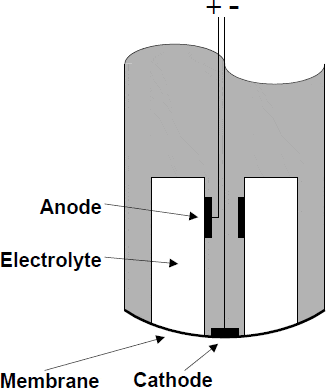
Schematic of Fuel Storage and Supply System for diesel generator
The main storage tank is used for the storing of fuel received from external supply. The capacity of the tank depends on various factors like required duration of coverage, supply lot size, ease of getting supplies, storage space availability, space for fuel expansion, accumulation of condensation and sediments etc. The main storage tank is kept away from the generators, buildings and other plant equipment for reasons of safety and accessibility for refilling. Figure 8.5 shows the construction details of a typical fuel storage main tank:

Fuel Storage main Tank
Fuel from the main storage tank is transferred to a day tank having a smaller capacity located near the engine by means of a fuel transfer pump. Duplex pumps are provided as redundancy for improved reliability. A manual fuel pump is also sometimes installed to serve as a back-up in the event of power loss for filling the day tank. The day tank generally has a capacity to feed the engine running on full load for about 24 hours. The tank is generally installed at an elevation so as to allow gravity feed to the engine or as recommended by the engine manufacturer. The quantity of fuel stored in the day tank is dictated by the following factors:
- Storage of sufficient quantity of fuel to run the generator in the event of a failure in the day tank fuel supply pump or fuel replenishing control system
- Sufficient quantity of fuel storage to minimize turbulence caused by the supply and return flows of fuel to and from the engine
The day tank is provided with a glass level gauge for manual monitoring and level switches for automatic control of fuel level as well as generation of automatic alarm signals in the event of abnormality in fuel levels. The overhead day tank is generally provided with the following accessories:
- Flame Arrestor
- Inspection Man Hole
- Level Gauge indicator with Alarm Contacts
- Float Switch
- Drain Port
- Supply Port
- Maintenance and Operation Platforms
A fuel cooler is provided to cool the fuel being returned from the engine to the day tank. Cleaning of the fuel is achieved by using fuel filters of a self cleaning type with sludge pump or dual flow replaceable cartridge type. Galvanized steel should not be used for the construction of the fuel tank or the pipings due to contamination of fuel by the galvanized coating.
The following are guidelines for the design, installation and protection of the fuel tanks:
- Fuel storage tank shall be designed and constructed in accordance with recognized standards (UL 142/2244 or equivalent)
- Main storage tanks shall be located away from important buildings, public ways and other tanks, and provided with seismic protection in compliance with the standards
- Protection for the tanks shall be provided from vehicle accidents by means of guard posts or other recommended means
- Tanks shall be provided with containment construction to prevent the spread of fuel in the event of spillage
- Protection shall be provided to prevent overfill of the tank (mechanical float valve, alarm and level control switches)
- Adequate fire protection equipment shall be provided near the tank
- Access shall be provided for approach of fire control apparatus, which shall not be obstructed at any time
- The capacity of the fuel tank is dictated by the number of hours or days of operation the generator is expected to run, and the speed and frequency with which fuel can be procured
- Storage tanks should be designed, constructed and installed in compliance with good engineering standards and rules and regulations
- All the storage tanks used for fuel storage should be provided with identification and hazard display markings
- Storage tanks should further be provided with drainage and impounding systems, such as dikes in order to safely contain any fuel that has been discharged or leaked from above ground storage tanks
- Such drainage systems should be designed, constructed and operated in such a way as to prevent contamination by discharge to public waterways, public sewers or adjoining properties
The fuel storage tanks should be provided with at least two ground connections for protection against static electric discharges which might cause an explosion. The two connections are provided at diametrically opposite sides of the tank. Figure 8.6 shows the ground connection method for a vertical fuel storage tank:

Grounding of Vertical fuel storage tank
The following are some guidelines for the grounding of fuel storage tanks:
- Each grounding rod should have a maximum resistance of 10 ohms under the worst case condition
- Ground wire should be preferably uninsulated for ease of inspection for mechanical damages and disconnections
- Electrical grounding and bonding systems should be included in the preventive maintenance schedules for ensuring the healthiness of the system
- The fuel tanks of the trucks or shipping containers containing flammable fuel should be grounded and bonded before transfer of fuel from the tank
Corrosion Protection
Underground fuel storage tanks and pipe lines are vulnerable to corrosion problems. Adequate protective measures should therefore be implemented to protect equipment from serious damages due to corrosion and consequent prohibitively expensive and time consuming repairs. The most widely used corrosion protection method is the cathodic protection system. There are two types of cathodic protection systems:
- Sacrificial anode system
- Impressed current cathodic protection system
Sacrificial Anode System
This system consists of a number of anode electrodes made from zinc or magnesium alloy, buried under the earth at various locations and connected to the tank or pipe line structures to be protected. The anode is at a slightly more positive potential than the steel equipment under protection. This causes an electron current to flow through the circuit from the cathode (protected equipment) to the anode electrode through the metal interconnection, the current path being completed through the ground as shown in the Figure 8.7:

Sacrificial anode corrosion protection
The anode gets corroded due to electrochemical action, thereby protecting the equipment from corrosion. The anode is covered by a back fill consisting of charcoal etc. to improve contact with the surrounding soil.
Advantages and drawbacks of sacrificial anode system:
- Simple system
- Low maintenance requirements
- Low installation and maintenance costs
- Low driving potential. Hence, may get affected by stray external currents
Impressed Current Protection
Impressed current corrosion protection system consists of buried electrodes which are made positive with respect to the protected steel structure by using a DC power supply system. Various metals are used for the fabrication of the electrodes:
- Graphite
- High silicon cast iron
- Tantalum, Titanium
- Metal oxides
Figure 8.8 shows an impressed current cathodic protection system. The rectifier charges injects a current through the circuit (hence the name ‘impressed current’) as shown in the figure:
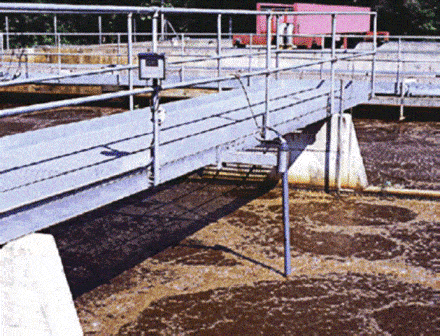
Impressed current corrosion protection
The impressed current system has advantages and disadvantages over the sacrificial anode system as shown below:
- Higher driving potential. Hence can protect large structures and can be used in low conductivity soil locations
- More complex than sacrificial anode system
- More maintenance intensive
- Higher installation and maintenance costs
- Current flows can cause interference to other neighboring systems
- Failure of power or circuit disconnections will render the protection inoperative
- Wrong connection of the positive and negative leads to the electrodes and the structure will result in escalated corrosion of the structure to be protected
8.4 Special requirements in extreme climates
Operation of the engine generator in extremes of climates, be it high temperature or low temperature has its problems which need special attention. These problems arise out of the following factors:
- At very low temperatures (below the pour point) fuel or lube oil may stop flowing, resulting in clogged filters, damages due to lubrication failure, fuel starved engine etc. Diesel gels at very low temperatures and this would result in the failure of the engine to run
- Engine coolant (if water) may get frozen leading to cracked pipelines, failure of the engine to startup, circulation failure etc.
- Battery capacity gets reduced at lower temperatures and this may prevent the batteries to supply adequate power for startup of the engine. At very low temperatures, the battery electrolyte may even freeze up and once the electrolyte is frozen, irreparable damage is caused and the battery may well have to be replaced
- At very low temperatures, condensation may occur inside the generator, resulting in moisture absorption by the generator windings
- At extremely high temperatures, lube oil may become thin resulting in inadequate lubrication of the moving components
- At very high temperatures, vapor locks may develop in the fuel line leading to improper operation of the engine
- Higher temperatures of the engine and generator may result in a derating of the generator capacity
The adverse effects of extreme low temperatures can be mitigated through implementation of the following steps:
- Anti freeze additives (ethylene glycol) to the coolant to prevent freezing during extreme cold temperatures
- Controlled ambient temperatures using air conditioners, good ventilation
- Space heaters for generators to prevent condensation in the windings
- Radiator bypass system for the coolant during low temperature conditions
- Lagging of fuel and lube oil pipe lines and storage tanks, incorporation of electric heat tracing of pipelines to prevent the ill effects of low temperatures
Figure 8.9 shows the effect of the addition of antifreeze to the engine cooling water. The boiling temperature increases and the freezing point reduces with an increase in the concentration of the antifreeze agent in water. As can be seen in the graph, beyond a concentration of about 60%, the antifreeze property of the additive starts losing its effect.
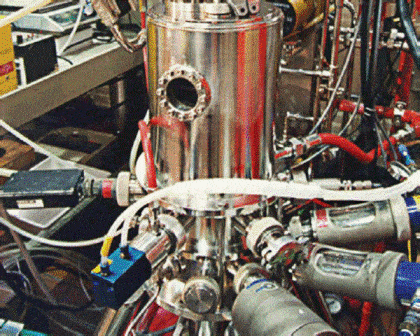
Effect of antifreeze on boiling and freezing temperatures of coolant
8.5 Regular and routine start up for checking
The emergency generator, by nature of its function, is expected to run only when there is a power interruption. Hence, in the absence of power failure, the generator may be forced to be idle for long periods of time. However, such idle condition of the generator will have the following repercussions:
- Components of the generator may corrode, seize up, get blocked due to lack of movement and lubrication
- At the critical moment of a power failure, the generator may fail to startup on account of some deterioration which had gone unnoticed
- Most fuels deteriorate if they are kept stored for very long periods of time. Such deteriorated fuel may affect the performance and condition of the engine
- Lack of practice due to long periods of disuse of emergency procedures, may cause the operators to lose touch with the emergency procedures
- Batteries, if used for generator startups, even if they are on trickle charge, may gradually start deteriorating due to plate sulphation
To avoid such problems, it is recommended to regularly start the generator according to a schedule: run for a few hours with sufficient load to keep the generator exercised and fit for action. The duration of running should be at the minimum sufficient to bring the engine to a stabilized temperature. In addition to keeping the engine healthy, such routine running will also bring any developing problems to light, which can then be investigated and solved with ample time at hand, instead of creating a surprise during a real emergency startup. The schedule for the routine running of the generator is best done in line with the recommendations of the manufacturer. The basic checks that can be performed during the routine startups are as follows:
- Time taken for the startup
- Engine coolant temperature
- Engine RPM
- Lube oil pressure
- Lube oil temperature
- Any abnormal noise or vibration
- Stable running of the engine (no hunting of speed)
- Leakages in fuel, lube oil lines
- Turbo charger temperature
- Performance of the engine-generator on load
- Proper functioning of the meters and gauges
8.6 Diesel generator trouble shooting
Here are some tips on trouble shooting of diesel generator sets.
| Engine (Electric start): No cranking/Slow cranking | |
| Electric System |
|
| Lubrication System |
|
| Fuel System |
|
| Mechanical System |
|
| Engine (Electric start): Cranks but no start | |
| Fuel System |
|
| Air supply/exhaust System |
|
| Mechanical System |
|
| Engine (Air start): No cranking/Slow cranking | |
| Air System |
|
| Lubrication System |
|
| Fuel System |
|
| Mechanical System |
|
| Engine: Cooling System | |
| Very high engine temperature |
|
| Engine: Fuel System | |
| High fuel consumption |
|
| Engine: Lubrication System | |
| Low lube oil pressure in engine |
|
| Very high lube oil pressure |
|
| High oil consumption |
|
Engine: Lack of Power
- Defective fuel pump
- Clogged fuel filter
- Bad quality fuel
- Defective injection pump
- Incorrect injection timing
- Clogged air filter
- Incorrect lube oil viscosity
- Overcooled engine
- Overheated engine
- Low compression pressure
Engine: White/Blue Exhaust
- Low compression pressure
- Poor quality fuel
- Incorrect injection timing
- Defective coolant thermostat
- Overcooled engine
- Excess lube oil in engine
Engine: Black/Grey exhaust
- Incorrect fuel injection timing
- Defective fuel feed pump
- Poor quality fuel
- Defective fuel injection pump
- Insufficient air supply (clogged filter)
- Defective valves
- Low compression pressure
9
Emergency Power Equipment: Cabling and Earthing
9.1 Earthing of emergency power sources
The type of grounding system and the arrangement of system and equipment grounding conductors have a direct impact on the continuity of power supply by an emergency system. There are two types of grounding: equipment grounding and system grounding. Equipment grounding refers to the connection of non-current carrying metal parts of the equipment such as frame, enclosure etc. to the ground. Equipment grounding is used for the safety of personnel from electric shock hazards. System grounding refers to the grounding of the power system such as the grounding of the neutral of the system. The grounding system should ensure the following:
- Objectionable stray neutral currents do not exist
- Ground fault currents flow in low impedance predictable paths
- Protection of personnel from electric shock
- Proper operation of protective equipment
Various grounding methods are adopted for the power system, namely ungrounded system, solid grounding, low resistance grounding and high resistance grounding. It is recommended to ground the neutral of medium voltage emergency generators with a low-resistance grounding system and not with a solid grounding system. Solidly grounded generators typically experience 20-50% higher fault current under ground faults than under three-phase faults. Ground fault current is limited in a resistance ground system, usually with a neutral grounding resistor rated 200-400 A, 10 seconds.
In an islanded generator system, resistance grounding of generator neutral provides more reliability of supply than a generator system with solid grounded neutral, since the fault protection relays will not trip in the event of a single point ground fault. Supply continuity would be maintained, providing time for the ground fault to be identified, located and rectified. However, if the ground fault is not detected promptly and rectified and a second ground fault occurs, it would result in the tripping of the generators.
Figure 9.1 shows the neutral of the emergency generator directly connected (not switched) with the neutral of the utility power supply transformer and that the neutral of the transformer is solidly grounded. The neutral point of the generator in such a system should not be grounded at the generator point in order to avoid flow of stray neutral currents, which may affect the operation of ground fault protection equipment:

Solid connection of utility and emergency generator neutrals – Generator neutral not grounded at generator
Figure 9.2 shows the same setup as Figure 9.1, but with the neutral of the emergency generator grounded at the generator point. Such grounding results in multiple ground points causing stray neutral currents to flow as shown in the figure. Such stray currents will result in the malfunctioning of the ground fault sensing equipment:
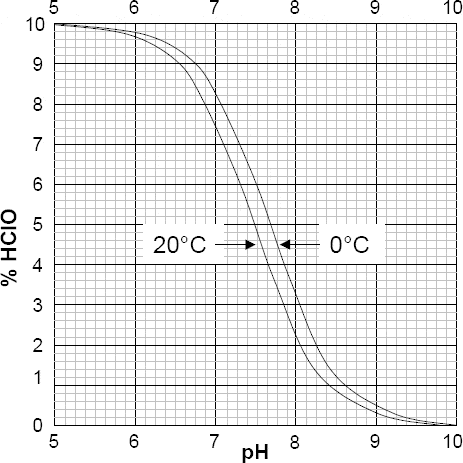
Solid grounding of utility neutral and emergency generator neutral causing stray currents
Figure 9.3 shows an unlinked utility-generator neutral system with the load not using a neutral. In this case, the generator neutral may or may not be connected to ground at the generator point as illustrated in the figure:

Utility-Generator neutrals not connected. Generator neutral can be grounded at generator point
9.2 Special requirements for multiple generator earthing
Figure 9.4 shows a multiple generator system, where the generator neutrals are not switched, and are grounded at the generator switchgears and not at the generators. If the neutral is provided with a switching system, then the neutral of the generators can be grounded at the generator point itself.

Grounding for Multiple generator system
A switched neutral system with neutral grounded generator system is preferable due to the following reasons:
- The neutral point voltage at the generator point may not be the same as the neutral point of the utility due to the distance between the two sources
- If the generator neutral is not connected to ground, it may not be possible to have proper ground fault protection
- In an ungrounded generator system with unisolated generator neutral connections, the occurrence of a fault may result in problems of tripping of both the utility source and the generator breakers causing total outage
When multiple emergency generators are in operation in parallel mode, their neutral point should be grounded only at a single point through the grounding resistor. Grounding of neutrals of several generators at multiple points would result in stray circulating currents between the generators, and may result in tripping due to malfunction of the protection relays.
9.3 Grounding of UPS derived supplies
Grounding of the output supplies derived from UPS systems is important because incorrect grounding practices may introduce noise in the output of the UPS and can interfere with the functioning of sensitive circuits connected to it. We will therefore discuss a few examples of the grounding possibilities of such systems. IEEE standard: 142:1991 illustrates many configurations of UPS derived power supplies and their grounding.
The basic approach with regard to grounding of UPS derived power supplies is outlined by the standard as follows:
- The neutral (grounded circuit conductor) should be bonded to the equipment safety-grounding conductor and to the local ground such as building ground network or other made electrodes.
- The grounded conductor from neutral should be connected to the grounding conductor only at the source and not at any other point since it will make the ground fault protection ineffective
The first means, that the neutral of UPS derived supplies must be connected to the equipment safety ground (such as the grounding connection of the conductive enclosure) and in turn to the building ground. The second means that the above connection should exist only at the source and not at any other downstream point.
The important consideration is that the UPS output supply must have a galvanic isolation from the mains input. This should be true in all states of UPS operation. This means that the loads may be connected to the inverter, the mains through static switch or the maintenance bypass. The isolation must exist in all these cases. If this is not so, the UPS output cannot be considered as a separately derived source and therefore the output neutral cannot be independently grounded.
This principle is illustrated in the various configurations illustrated below, some of which are examples of separately derived sources whereas others do not qualify to be so considered. The inverter module itself is generally considered to be an isolated source in these examples, though in practice it may need to be specifically isolated for this purpose.
9.3.1 Configuration 1
In this case, the bypass source and the UPS source are the same. The bypass circuit (switched through the static switch) has no isolation and is connected directly to UPS output. Thus, the definition of separately derived source is not satisfied. The UPS neutral is not therefore connected to the grounding conductor of equipment or to any local grounding electrode. Since there is no isolation between the source and the loads, attenuation of common mode noise is not ensured (see Figure 9.5).
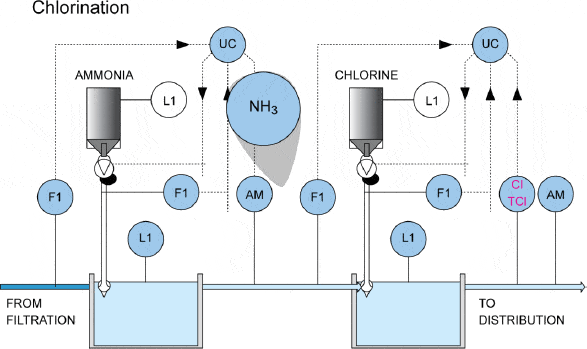
UPS system configuration 1
9.3.2 Configuration 2
In this case, the bypass supply is obtained through a delta-wave transformer and thus there is galvanic isolation between the input supply to the UPS and the output under all conditions. The UPS can therefore be considered as a separately derived source. The neutral point of the UPS is bonded to the downstream equipment grounding wire as well as local grounding electrode. The bypass supply neutral is also bonded to UPS output neutral to provide a return path for neutral currents when bypass circuit is in operation (note that the static bypass switch is in line wires only and the neutral connection is direct). Common mode noise performance is better in this circuit if the neutral connection between bypass and UPS is kept short (see Figure 9.6).

UPS system configuration 2
9.3.4 Configuration 3
This configuration, shown in Figure 9.7, has a non-isolated bypass but the UPS output is taken to the loads through a distribution center, which incorporates an isolation transformer. Thus, the UPS module is not a separately derived source by itself but the secondary of the isolation transformer is a separately derived source.
Thus, the neutral of the UPS module is not bonded to the local bonding conductor. However, the isolation transformer neutral is bonded to the grounding wire from the computer loads fed by it as well as to the local grounding electrode system.
In this configuration, the power distribution center can be placed as close to the loads as possible so that it gives a better common mode noise protection compared to the earlier configurations. The isolation transformer can also be used as a step down transformer permitting lower voltage supplies (208/220 V) to be served by UPS modules of higher voltage (380/415/480), which improves the cost effectiveness of the design for UPS and wiring.

UPS system configuration 3
9.3.5 Configuration 4
This configuration (shown in Figure 9.8) is similar to configuration 3 except that the service (mains) neutral is not brought to the UPS or the bypass module. Thus, both UPS module and the distribution center can be treated as separately derived sources and neutral to ground connection is established in both these installations. Noise performance is similar as that of configuration 3.

UPS system configuration 4
9.3.6 Configuration 5
This case (Figure 9.9) is similar to configuration 2, except that the supply is from a delta connected three-wire source. Therefore, the UPS is a separately derived source and the neutral/ground connections reflect this. Noise performance is similar to that of configuration 2.

UPS system configuration 5
9.3.7 Configuration 6
This is an example of multiple UPS modules with an isolated bypass and a standalone static transfer switch configuration (Figure 9.10).
The combination of UPS modules and bypass can be treated as a single separately derived source. In order to create a common bonding point, the neutral of the bypass source and each UPS module are brought into the static switch module and connected to a neutral bar. A separate ground bus is also provided in the same cubicle. The neutral bar is bonded to the ground bus. All equipment grounding wires from the loads and the UPS are bonded to this bus. The ground bus is also bonded to the local grounding electrode and to the service ground.
This arrangement permits any UPS module to be taken out of service without affecting the integrity of grounding connections. Common mode noise attenuation is also achieved by separation of the service neutral from the sensitive load supply neutral.
There are other possible UPS configurations, which we will not discuss here. But the general guiding principles in all these cases remain the same.

UPS System configuration 6
9.4 Cable sizing issues
The cable sizing study selects the conductor size based on the minimum conductor material and cross-sectional area necessary to meet defined feeder current carrying capability, and associated voltage drop criteria.
Feeder sizes are based on the design load value from the Demand Load Study. The Demand Load Study calculates the total connected demand and design load in each branch of the emergency power system. Some loads are defined as continuous loads and as such, the design load value is larger than its demand load value. The National Electric Code (NEC) requires branch circuits that serve continuous loads be rated so that not more than 80 % of the feeder current rating is used. Selecting a design load value of 125 % (1/80 %) of the demand load value meets the NEC standard. The feeder current rating is defined as the current in amperes that a conductor may carry continuously under the conditions of use without exceeding its temperature rating.
The cable sizing study is based on the calculations of two separate criteria: the minimum conductor cross-sectional area to meet feeder current rating values and a user-defined voltage drop value. If parallel feeder combinations are considered for a specified conductor type, selection can be made for multiple feeders in parallel for that conductor. Derating factors are determined based on the ambient temperature, thermal resistivity of soil, depth of laying of the cable, cable grouping factor and duct bank design detail criterion.
The Sizing Study selects the cable that best meets defined current rating values and has the smallest cross-sectional area. Once the cable is selected, the voltage drop for the cable is calculated. If the voltage drop criterion is exceeded, the next larger cable size is selected and a reiteration of the comparison of cross-sectional area, rated current and voltage drop is performed.
The feeder branch design load value in amperes is first determined and then the selected feeder design current rating is arrived at. The design load value is the rated size of the load multiplied by specified demand factors and the long continuous load factor (or design factor). The feeder design rating is the product of the rated current, the temperature derating factor and the number of parallel cables.
Once the current rating conditions are met, the voltage drop on the cable is calculated, based on the branch design load current and power factor, cable impedance, and length.
The voltage drop is calculated using the following formula:

Where ‘R’ is the resistance, ‘X’ is the reactance of the cable and VLL is the line to line voltage. If the voltage drop exceeds the specified level, the next largest feeder size is chosen and the calculation performed again in order to select a cable or combination of parallel cables which meets the rating criteria of minimum cross-sectional area and acceptable voltage drop.
The following factors should be taken into consideration in cable sizing:
- Load Current
- Derating Factors:
- Depth of cable burial
- Thermal resistivity of soil
- Ambient soil temperature
- Group factor
- Maximum permissible conductor temperature
- Permissible voltage drop
- Short circuit withstand capability: magnitude and duration
- Motor startup requirements
Consider the example of a load having a load current of 40 amps. The load is to be connected to the supply using low voltage XLPE insulated copper cable. Figure 9.11 shows the details of the installation and Table 9.1 gives the calculation data for the system:

Cable sizing calculation – Example
Cable Derating Calculation
| Cable Manufacturer Data | Site Condition | Derating Factor | |
| Depth of cable burial | 0.7 m | 1.0 m | 0.96 |
| Soil thermal resistivity | 1.0 °C km/w | 1.2 °C km/w | 0.95 |
| Ambient soil temperature | 20° C | 30° C | 0.93 |
| Group factor | Single cable | 2 cables touching | 0.77 |
| Maximum conductor temp. | 90° C | 90° C | 1.0 |
| Net Derating factor (multiply all derating factors) | 0.65 | ||
Cable Sizing Calculation
Load current – 40 Amps
125% margin on load current – 1.25 x 40 = 50 Amps
Derating factor – 0.65
A 3 core, 16 mm2 XLPE Copper cable with rated capacity of 96 amps, derated capacity 62 amps can be used.
In sizing the cables, special consideration should be given in determining the size of the neutral conductor. In a balanced three phase system, the current in the neutral is negligible and normally 3½ core cable would suffice. However in unbalanced and high harmonic systems, the current in the neutral can be substantial and can even be more than phase current. The 3rd harmonic currents add up in neutral line instead of canceling out with the neutral current typically going up to 170% of phase current. Figure 9.12 shows the waveform of the 3rd harmonic currents and the path of these currents in a circuit. In such cases, an inadequately sized neutral conductor would result in cable overheating and fire hazard. For such cases, size neutral core, based on:
- Load Imbalance currents
- Harmonic currents

3rd Harmonic current waveform and current paths
The derating factor for the cable should be chosen based on line current or on neutral current depending on triple-N harmonic line current percentage. This is shown in Table 9.2.
Cable derating factor based on Triple-N harmonic line current percentage
| Triple-N harmonic line current (%) | Cable derating factor based on line current | Cable derating factor based on neutral current |
| 0 – 15 | 1.0 | – |
| 15 – 33 | 0.86 | – |
| 33 – 45 | – | 0.86 |
| > 45 | – | 1.0 |
Shown below is a sample calculation explaining the cable selection method taking into consideration the Triple-N harmonic line current percentage.
Sample Calculation
Consider a 3 phase circuit with 36 amps load connected by 4 core, Cu cable. A 6 mm2 cable (capacity-41 amps) is adequate in the absence of harmonics. However with 20%, 3rd harmonic currents, considering a derating factor of 0.86 the calculated load current becomes 36/0.86 = 41.86 amps. Hence a 10mm2 cable is needed. With 50% harmonic, cable size would be based on neutral current = 36×0.5×3 = 54 amps. With derating factor 0.86, current = 54/0.86 = 62.8 amps. 16mm2 cable is needed.
Having selected the size of the cable, a final confirmation should be made regarding the short circuit capability of the cable, particularly for MV cables and above. The cable should be able to carry the short circuit current without deterioration for the duration required by the protection system to isolate the fault. Short circuit currents of even short duration can cause irreparable core, insulation damage.
Figure 9.13 shows the short circuit current vs time characteristics of cables which shows that the higher value the current, the shorter the duration the cable can carry the current:

Short circuit current vs time characteristics of cable
If short circuit protection is given to cables by using fuses, then it is possible to use lower capacity cables than if the protection had been given using circuit breakers. Fuses are faster than breakers in clearing short circuits. Refer to Figure 9.14 for comparison of the fault clearing time required for fuse as against the time required by breakers:

Fault clearing time – Fuse vs Circuit breaker
Current interruption in the case of fuse protection, occurs in about 5ms time whereas the duration is approximately 200ms in the case of circuit breaker protection. Since the fault current duration is reduced by a factor of 40, smaller size cables can be used with fuse protection. Table 9.3 provides a comparison of the cable sizes required for a motor when using fuse protection and when using breaker protection.
Cable size comparison – Fuse protection vs breaker protection
| Motor Current (Amps) Fault level – 31.5 kA | Cable Size (mm2) Fuse protection | Cable Size (mm2) Breaker protection |
| 60 | 35 | 185 |
| 90 | 50 | 185 |
| 150 | 50 | 185 |
| 225 | 70 | 185 |
9.5 Routing of cables: precautions to avoid simultaneous failures by physical separation
The cables supplying normal power and cables supplying emergency power to the critical loads should be laid through different routes and physically separated from each other. This is to ensure the continuity of power supply in the event of damage to either one of the supply cables due to reasons of fire, excavation, structure damage, etc. The switchgear for the supply of normal power and emergency power are also installed in separate power control centers, to ensure supply continuity in the event of a power control center being out of service due to maintenance, breakdown, etc.
9.6 Emergency power for hazardous installations
The cables installed for supply of emergency power (for instance to emergency exhaust fans, emergency lighting etc.) in hazardous locations are expected to perform even in the event of an emergency situation like fire. The cables should continue to function during the course of a fire for a specific period of time, which enables the safe evacuation of personnel, safe shutdown and operation of smoke handling systems, emergency lighting etc. Therefore, these cables have to satisfy additional requirements to survive during fire and hose stream exposure. The insulation of these cables should be able to withstand high temperatures for a stipulated period of time and should possess flame retardant and low smoke emission properties. Silicone, glass fiber and flame retardant low smoke zero halogen cross-linked polyolefin (XLPO) are the generally used insulation materials having such properties. Halogen free cable insulation should be used, since insulation with halogens produce smoke that is corrosive and poisonous when burning. Mineral insulated (MI) cables using magnesium oxide insulation are suited for very high temperature applications and division 1 hazardous locations. The rating of a fire resistant cable is mentioned in terms of ‘Two hour fire rating’. It denotes the ability of the cable to carry a voltage and current successfully when subjected to a high temperature over a period of two hours.
The specification of the cable used in a particular application should be in accordance with the relevant rules pertaining to the application and area where the cable is used. A cable that is UL listed to a particular fire safety rating, will have its rating printed on the cable. This would typically include the fire safety rating, the approval reference number and the UL identifier, which is either the UL logo or UL in parentheses. The fire protective systems are evaluated with respect to two criteria: namely, fire exposure and hose stream performance. Standard ANSI/UL 2196 describes two fire exposure conditions. The normal temperature rise (ANSI/UL 263) is intended to represent a fully developed interior building fire. The rapid temperature rise (ANSI/UL 1709) is intended to represent a hydrocarbon pool fire. Similarly there are two hose stream levels of evaluation of cables: normal and low impact.
The fire ratings of cables should be assessed as an entire protective system assembly, constructed using the combination of components specified in the system. For example, the fire rating of wall or floor ceiling assembly must be equal to or greater than the rating of the electrical circuit protective system in order to ensure that the complete electric circuit protective system will survive during a fire and hose stream exposure.
10
Safety in Emergency Power Supplies
10.1 Fire safety
Fire safety is of paramount importance in an engine generator power system, owing to the storage, handling and usage of inflammable fuel. The installation of fuel storage and handling equipment should be in accordance with the statutory rules and regulations. Every precaution has to be taken to prevent fire while at the same time, adequate and pertinent fire detection and extinguishing equipment should be provided for handling the outbreak of a fire.
Fire prevention and containment can be addressed by adopting the following measures:
- Do not store fuel in makeshift containers in the vicinity of the engine or near hot surfaces
- Prevent leakage of fuel in pipe lines, engine, valves, tanks etc
- Maintain adequate ventilation around the engine to prevent the development of abnormal temperatures
- Ensure that hot surfaces like the exhaust system lines are well insulated and isolated from ignitable material
- Ensure that safety valves, pressure relief and over temperature sensing devices are in good operating condition
- Maintain good housekeeping in and around the generator area
- Ensure that the relay protection system is in a healthy operation condition. A malfunctioning relay can cause a major electrical flashover or arcing hazard
- Prevent unauthorized entry of personnel into the generator area
- Personnel should not enter pits, tanks, low places or confined spaces in the fuel storage and handling areas without gas testing and obtaining a confined space entry permit, since there is a likelihood of an accumulation of flammable gases
- Flammable liquids should not be stored in open containers
- Prohibit unauthorized usage of ignition sources and activities like welding, brazing, grinding, smoking etc. in the vicinity of the fuel storage and generator area
- Ensure that flame proof equipment and lighting are used in fuel storage area
- Fuel storage areas should be provided with adequately sized access passages and aisles and maintained to ensure unobstructed access and movement of fire fighting personnel and equipment
- Ensure that emergency exits are always kept clear of material and identified by well lit fire exit displays
- Fuel spill/leak and emergency response procedures should be in place and training should be provided to personnel on these procedures
- Install fire alarm boxes at easily accessible locations for manually activating the alarm
- Install adequate quantities of appropriate fire fighting equipment in easily accessible points suitable for fuel based fires and electrical fires. Water types should not used for fuel fires. Table 10.1 shows the flammability classifications of common fuel and Table 10.2 gives the classes of fires and the types of extinguisher to be used for each class of fire. Water and foam type extinguishers should not be used for electrical fires
- Establish and implement emergency procedures for combating fire
- Train operational personnel in fire fighting and emergency procedures
Flash point is the minimum temperature at which a liquid gives off vapor within a test vessel in sufficient concentration to form an ignitable mixture with air near the surface of the liquid. Table 10.1 provides the Flash points and flammability classification of some general purpose fuels.
Flash points of fuels and flammability classifications
| Fuel | Flash Point | NFPA Class |
| Diesel | 38°C | II |
| Gasoline | – 43°C | I |
| Kerosene | 38 – 72°C | II |
Table 10.2 shows the classes of fires and suitable types of fire extinguishers:
Fire extinguisher types and applications
| Class of Fire | Nature of Fire | Suitable Type of Extinguisher |
| A | Common combustibles-wood, paper, cloth, rubber, trash and most plastics | Water type |
| B | Flammable liquids-gasoline, kerosene, oil, grease, solvents and paint | Dry chemical, Halon, CO2 |
| C | Live electrical equipment-motors, computers, wiring and appliances | Dry chemical, Halon, CO2 |
When fuel is transferred from storage drums to other metal containers, static charges may develop resulting in sparking and consequent fire hazard. To avoid the risk of fire due to static charges, the following actions should be taken.
- The potentials of both the metal containers should be made equal by connecting them with bonding cable and clamps
- The container should further be earthed to ground to divert the charges to ground
Figure 10.1 shows the earthing arrangement for fuel storage drums and the metal containers to which fuel is transferred:

Fuel drum and transfer container grounding method
10.2 Battery safety
Batteries are highly hazardous because of the corrosive acid used as electrolyte. Therefore they should be handled carefully during transportation, handling, usage and maintenance. Following are the tips for proper and safe installation of batteries:
- Follow battery manufacturer’s instructions
- Install the batteries on specially built steel racks of bolted or welded construction
- Take care to connect the batteries with correct polarity. Total voltage of battery bank should be equal to the sum of all the individual cells in the bank; difference indicates incorrect battery connection. Incorrect connection of battery will damage the incorrectly connected battery
- The busbars, cables should be of adequate cross section to reduce voltage drops
- Lugs used for termination of cables and busbars should preferably be nickel plated to reduce corrosion
- Cables, busbars should not touch the top portion of the battery and electrolyte splashes should not come in contact with the busbars or cables
- The vent plugs should be screwed tightly and the holes for breathing should be free from blockage or plugging
- Rubber cushioning should preferably be provided between clamps and battery jar to reduce stress
- Battery storage location should be well ventilated to prevent accumulation of hydrogen and its consequent explosion risk hazard. The ceiling should be designed so as not to have pockets that will facilitate accumulation of hydrogen.
- Battery storage area should be provided with good illumination
- Battery charger should be installed as close to the battery bank as possible
- Adequate space should be provided to facilitate easy ingress and egress of personnel, transportation of batteries and associated equipment, further expansion
- Temperature differential between cells should be not greater than 3ºC at any point of time
Personal protective equipment for battery handling/maintenance:
- Goggles, face shield
- Acid resistant gloves
- Acid resistant aprons and shoes
- Eye wash water fountain
- Acid neutralizing agent: Bicarbonate of soda solution
- Class C fire extinguisher
- Insulated tools
Appendix A
Practical Exercises
Problem 1: Determination of Cable Size
Objective
To determine the size of 3-core XLPE copper cable for a three phase motor load, drawing full load motor current of 162 amps. Length of the cable run is 340 metres. Cable is buried under soil at a depth of 1.0 meter. Maximum ambient temperature of soil is 40 °C. Thermal resistivity of soil is 1.2 ºC Km/W.
Calculation
The required ampacity of the cable supplying continuous loads is calculated at 125 % of full load current. Therefore the required ampacity of cable considering the margin of 25% = 162 x 1.25 = 202.5 Amps
Derating factors for variations in ambient temperature, grouping, etc are to be considered and then the overall derated ampacity of the cable is calculated.
Derating factor due to burial depth DF1
Derating factor due to soil thermal resistivity DF2
Derating factor due to ambient soil temperature DF3
Derating factor due to grouping DF4
Derating factor due to max conductor temp DF5
| Cable Derating Calculation | |||
| Cable Manufacturer Data | Site Condition | Derating Factor | |
| Depth of cable burial | 0.7 mt | 1.0 mt | 0.94 |
| Soil thermal resistivity | 1.0 ºC km/w | 1.2 ºC km/w | 0.9 |
| Ambient soil temperature | 20 deg C | 40 deg C | 0.85 |
| Group factor | Single cable | 2 cables touching | 0.77 |
| Maximum conductor temp. | 90 deg C | 90 deg C | 1.0 |
| Net Derating factor (multiply all derating factors) | 0.55 | ||
Overall derating factor DF = DF1 x DF2 x DF3 x DF4 x DF5
Consider using a 3 core, 240 sqmm copper cable having ampacity of 450 Amps.
Applying derating factor of 0.55, derated ampacity of the cable = 450 x 0.55
= 247.5 > 202.5 Amps
i.e The selected cable is adequate for carrying the full load current of the motor.
Verify the above cable sizing for short circuit current suitability.
Let the fault level IC be 31kA
Considering a maximum protection time of t = 1 sec
Size of cable in mm2 for this fault level q = ( IC x √t ) / 0.143
= ( 31 x √1) / 0.143 = 216.78 mm2
Selected cable size 240 mm2 > 216.78 mm2.
Hence the 240 mm2 cable is suitable for the short circuit availability in the circuit.
Conclusion
The motor can be supplied power using the 3 core, 240 mm2 cable.
Problem 2: Calculation of Cable voltage drop
Objective
To calculate the voltage drop in the cable installation mentioned in Problem-1 and check whether the voltage drop meets specified limits.
Data:
| Power factor at full load conditions (cos φ) | = 0.9 |
| i.e corresponding (sin φ ) | = 0.44 |
| AC resistance of cable ( R) | = 0.0000993 O/ mt |
| AC reactance of cable (X) | = 0.00011 O/ mt |
| Number of cable runs (N) | = 1 |
| System voltage | = 4.16 kV |
Calculation
The selected cable size in Problem-1, is verified for voltage drop at the load end, under full load conditions. The resistance and reactance values of the cable have been taken from the cable manufacturer’s data sheet. If the voltage drop of the cable is less than criteria of 3% max., the selected cable size is acceptable. Otherwise, the next higher size of cable has to be opted.
Voltage drop in the cable = √3 x I x L x ( R cos φ + X sin φ) / N
| Where | I | = Full load current in Amps |
| L | = Length of the cable in metres | |
| R | = Resistance value of cable in Ohms per km | |
| X | = Reactance value of cable in Ohms per km | |
| Cos φ | = Power Factor | |
| N | = Number of parallel cable runs |
Voltage drop in the cable = √3 x 162 x 340 ( 0.0000993 x 0.9 + 0.00011 x 0.44) / 1
= 13.2 volts
Percentage voltage drop = (13.2 / 4160) x 100 = 0.003 %
< 3%
Conclusion
The voltage drop of the selected cable is within the specified range.
Problem 3: Calculation of Cable voltage drop during motor startup
Objective
To calculate the voltage drop in a motor cable during motor startup and check whether the voltage drop meets specified limits.
Data:
Motor full load current – 54 Amps
Starting current – 6 times full load current
Power factor (cos φ) – 0.85
System voltage – 480 volts
Size of cable – 50 mm2
Length of cable (L) – 72 mts
Resistance of cable (R) – 0.0004940 O/ mt
Reactance of cable (X) – 0.0000934 O/ mt
Calculation
Voltage drop during motor starting
= √3 (R cos φ + X sin φ) x (Starting current to FLC ratio) x FLC x L
= 1.732 x ((0.000494 x 0.85) + (0.0000934 x 0.53)) x 6 x 54 x 72
= 18.92 volts
Startup voltage drop percentage = Volt drop x 100 / System voltage
= 18.92 x 100/ 480
= 3.9 %
< 15 % which is normal standard for max startup voltage % drop
Conclusion
The voltage drop of the selected cable is within the specified criteria during motor startup
Problem 4: Determination of the size of Emergency Power Distribution Transformer
Objective
To determine the size of a 4.16/ 0.48 kV, 3 Ph, 3 wire emergency power distribution transformer supplying a total load of 400 kVA.
Data:
The growth Factor of existing loads is 10%
The projected future additional load is considered as 20% of the existing load
Calculation
Since all the loads may not be on all the time, diversity factor is considered.
Let the Load Diversity factor be – 1.05
Load to be supplied taking into consideration load diversity factor = 400/ 1.05 = 381 kVA
Taking into consideration 10% growth, the corrected load value = 381 x 1.1 = 419 kVA
Taking into consideration 20% projected future loads, the rating of the transformer = 419 x 1.2
= 502.9 kVA
Conclusion
Based on the above load calculations, a Distribution Transformer with a rating of 600 kVA, 4.16/ 0.48 kV, OA, Dyn11 can be selected for the emergency power supply.
Problem 5: Determination of UPS Rating
Objective
To determine the UPS rating for the control room instrumentation of a continuous process plant
Data:
UPS Output – 3 Phase, 120V
Loads connected to UPS:
Instrumentation Panel 1 – 16000 VA
Instrumentation Panel 2 – 14000 VA
Instrumentation Panel 3 – 11000 VA
Instrumentation Panel 4 – 6000 VA
Total Load – 47000 VA = 47 kVA
Transient power requirement by the loads – 55 kVA
Provision for future growth – 20%
Calculation
UPS load rating taking into consideration future growth – 47 x 1.2 = 56.4 kVA
Standard rating of UPS close to the above load – 60 kVA
Overload capacity provided in the UPS – 150% = 60 x 1.5 = 90 kVA
Transient power requirement – 55 kVA
Transient power requirement taking into consideration 20% future growth – 55 x 1.2 = 66 kVA
66 kVA < 90 kVA
Transient power requirement is less than overload capacity of 90 kVA of the UPS
Conclusion
UPS rating of 60 kVA is suitable for the intended application
Problem 6: Determination of UPS Battery Rating
Objective
To determine the battery ratings of an emergency static 60 kVA, 120V output UPS unit
Calculation
Number of Cells required:
| Total battery voltage | = 120 V DC |
| Considering a voltage tolerance of 17.5%, max system voltage | = 120 x 1.175 |
| = 141 V DC | |
| Equalizing voltage for each cell | = 2.35 V |
| Number of cells in the battery | = 141/ 2.35 |
| = 60 Cells |
Battery AH Capacity:

| Inverter kVA | – Inverter kVA at unity power factor = 60 kVA |
| Inverter effy. | – Inverter efficiency at battery end of voltage = 85% |
| VBatt end | – Battery end voltage = Cell end voltage x Number of cells |
| = 1.75 x 60 = 105 V | |
| PF | – Power factor = 0.8 |
| BT | – Battery backup time = 20 mins = 0.33 hr |
| TC | – Temperature compensation factor = 1.0 at 25 °C |
| AF | – Battery ageing factor = 1.25 for lead acid battery |
| DF | – Design factor (Margin) = 1.1 |

Battery AH = 221.8 AH
Conclusion
Battery with 60 cells having a minimum of 225 AH rating is required for the application
Problem 7: Determination of space requirements for UPS battery installation
Objective
To determine the space requirements for the UPS battery mentioned in Problem -5
Dimension of each cell:
Width – 275 mm
Depth – 250 mm
Height – 470 mm
Calculation
Total number of cells – 60 cells
Arranging the battery cells in the following configuration:
- Single tier arrangement of three racks
- Each rack having two rows
- Each row having 10 cells
Provide spacing of 10mm around each cell. Refer to figure for the installation configuration.

Battery layout
Calculation
Length of the battery rack – (10 x 250) + (9 x 20) = 2680 mm
Width of the battery rack – 20 + 275 + 20 + 275 + 20 = 610 mm
Conclusion
Minimum floor space required for the battery rack = 2680 mm x 610 mm
Problem 8: Detection of inter cell connection problem in a battery bank
Objective
To determine whether the inter cell connections in a battery bank are healthy and if not which connections need to be attended. Number of cells in the battery bank 60 cells.
Data:
Inter cell resistance measurements:
| Cell Number | Inter cell resistance (µΩ) | Cell Number | Inter cell resistance (µΩ) | Cell Number | Inter cell resistance (µΩ) |
| 1 | 159 | 21 | 165 | 41 | 165 |
| 2 | 157 | 22 | 171 | 42 | 171 |
| 3 | 157 | 23 | 159 | 43 | 163 |
| 4 | 165 | 24 | 171 | 44 | 263 |
| 5 | 171 | 25 | 169 | 45 | 168 |
| 6 | 163 | 26 | 162 | 46 | 171 |
| 7 | 263 | 27 | 161 | 47 | 169 |
| 8 | 168 | 28 | 159 | 48 | 162 |
| 9 | 171 | 29 | 158 | 49 | 161 |
| 10 | 213 | 30 | 154 | 50 | 159 |
| 11 | 168 | 31 | 159 | 51 | 164 |
| 12 | 164 | 32 | 171 | 52 | 167 |
| 13 | 167 | 33 | 169 | 53 | 163 |
| 14 | 163 | 34 | 162 | 54 | 622 |
| 15 | 617 | 35 | 171 | 55 | 160 |
| 16 | 160 | 36 | 163 | 56 | 157 |
| 17 | 157 | 37 | 272 | 57 | 171 |
| 18 | 162 | 38 | 168 | 58 | 169 |
| 19 | 161 | 39 | 159 | 59 | 162 |
| 20 | 161 | 40 | 158 | 60 | 161 |
Determination of inter cell resistance problem
For ease of identification of the problem, plot the resistance data in a graph as below. The problem locations are shown as high peaks in the graph plot.

Conclusion
Graphical plot quickly shows the inter cell connection problems to be in cells 15 and 54




Professional Certificate of Competency in Advanced TCP/IP-Based Industrial Networking
Designed for engineers and technicians who need practical knowledge in…Read moreProfessional Certificate of Competency in Allen Bradley Controllogix / Logix5000 PLC Platforms
Designed for engineers and technicians who need practical knowledge in…Read moreProfessional Certificate of Competency in Arc Flash Protection
Designed for engineers and technicians who work in the electrical…Read moreProfessional Certificate of Competency in Chemical Engineering and Plant Design
Designed for engineers and technicians who need practical knowledge in…Read moreProfessional Certificate of Competency in Circuit Breakers, Switchgear and Power Transformers
Designed for engineers and technicians who need practical knowledge regarding…Read moreProfessional Certificate of Competency in Control Valve Sizing, Selection and Maintenance
Designed for engineers and technicians who need a solid understanding…Read moreProfessional Certificate of Competency in Electrical Power System Fundamentals for Non-Electrical Engineers
Designed for engineers and technicians who need to understand the…Read moreProfessional Certificate of Competency in Electrical Power System Protection
Designed for engineers and technicians who need practical skills and…Read moreProfessional Certificate of Competency in Electrical Wiring Standards: AS/NZS 3000:2018 (Australia and New Zealand Only)
This professional development course is designed for engineers and technicians…Read moreProfessional Certificate of Competency in Fundamental E & I Engineering for Oil and Gas Facilities
Designed for engineers and technicians who need to update their…Read moreProfessional Certificate of Competency in Gas Turbine Engineering
Designed for engineers and technicians who need practical skills in…Read moreProfessional Certificate of Competency in Hazardous Areas and Intrinsic Safety For Engineers and Technicians
Designed for engineers and technicians who need to understand the…Read moreProfessional Certificate of Competency in Heating, Ventilation and Air Conditioning (HVAC)
Designed for engineers and technicians from a wide range of…Read moreProfessional Certificate of Competency in IEC 61850 Based Substation Automation
Designed for engineers and technicians who need to understand the…Read moreProfessional Certificate of Competency in Industrial Data Communications
Designed for engineers and technicians who need to understand how…Read moreProfessional Certificate of Competency in Instrumentation, Automation and Process Control
Designed for engineers and technicians who need to gain practical…Read moreProfessional Certificate of Competency in Machine Learning and Artificial Intelligence
This professional development course is designed for engineers and technicians…Read moreProfessional Certificate of Competency in Mechanical Engineering
This professional development course is designed for engineers and technicians…Read moreProfessional Certificate of Competency in Onshore and Offshore Pipeline Systems
Designed for engineers and technicians who need to gain an…Read moreProfessional Certificate of Competency in Power Distribution
designed for engineers and technicians who need to gain a…Read moreProfessional Certificate of Competency in Practical Machine Learning Using Python for Engineers and Technicians
Designed to use Python Programming to work with machine learning…Read moreProfessional Certificate of Competency in Practical Python for Engineers and Technicians
Designed for engineers and technicians who need to understand the…Read moreProfessional Certificate of Competency in Programmable Logic Controllers (PLCs) & SCADA Systems
Designed for engineers and technicians who need to get practical…Read moreProfessional Certificate of Competency in Project Management for Engineers & Technicians
This professional development course is designed for engineers and technicians…Read moreProfessional Certificate of Competency in Safety Instrumentation Systems for Process Industries
Professional development course designed for engineers and technicians who want…Read moreProfessional Certificate of Competency in Sewage and Effluent Treatment Technologies
Designed for engineers and technicians who need practical skills and…Read moreProfessional Certificate of Competency in Structural Design for Non-Structural Engineers
Professional development course designed for engineers and technicians who need…Read moreProfessional Certificate of Competency in Substation Design (Main Equipment)
Professional development course is designed for engineers and technicians who…Read moreProfessional Certificate of Competency in Substation Design (Control, Protection and Facility Planning)
Designed for engineers and technicians who need to gain practical…Read moreProfessional Certificate of Competency in the Fundamentals of Process Plant Layout & Piping Design
Professional development course is designed for engineers and technicians who…Read moreProfessional Certificate of Competency in Practical Mechanical Sealing
This professional development course is designed for engineers and technicians…Read moreProfessional Certificate of Competency in Fundamentals of Road Construction
This professional development course is designed for engineers and technicians…Read moreProfessional Certificate of Competency in Specification and Technical Writing
Designed for engineers and technicians who need to understand how…Read moreProfessional Certificate of Competency in Hydraulics and Pneumatics
Overview of all aspects related to the construction, design, operation,…Read moreProfessional Certificate of Competency in Big Data and Analytics in Electricity Grids
This course explores the use of big data & data…Read moreProfessional Certificate of Competency in Renewable Energy Systems
This course covers various renewable energy systems that are popular…Read moreProfessional Certificate of Competency in Hydrogen Energy – Production, Delivery, Storage, and Use
Hydrogen energy short course designed for engineers and professionals interested…Read moreProfessional Certificate of Competency in Earthing and Lightning Protection
Designed for engineers and technicians who need to understand the…Read moreProfessional Certificate of Competency in Building Information Modelling (BIM)
This professional development course is covering practical aspects of using…Read more




